
Cymen and Iphigenia.
By permission of the Fine Art Society
* A Distributed Proofreaders Canada eBook *
This eBook is made available at no cost and with very few restrictions. These restrictions apply only if (1) you make a change in the eBook (other than alteration for different display devices), or (2) you are making commercial use of the eBook. If either of these conditions applies, please check with an FP administrator before proceeding.
This work is in the Canadian public domain, but may be under copyright in some countries. If you live outside Canada, check your country's copyright laws. If the book is under copyright in your country, do not download or redistribute this file.
Title: The Treatment of Drapery in Art
Date of first publication: 1904
Author: George Woolliscroft Rhead (1854-1920)
Date first posted: Sep. 27, 2018
Date last updated: Sep. 27, 2018
Faded Page eBook #20180944
This eBook was produced by: Delphine Lettau, Howard Ross & the online Distributed Proofreaders Canada team at http://www.pgdpcanada.net
DRAPERY IN ART
GEORGE BELL AND SONS
LONDON: PORTUGAL ST. LINCOLN'S INN
CAMBRIDGE: DEIGHTON, BELL AND CO.
NEW YORK: THE MACMILLAN CO.
BOMBAY: A. H. WHEELER AND CO.

Cymen and Iphigenia.
By permission of the Fine Art Society
THE TREATMENT OF
DRAPERY IN ART
BY
G. WOOLLISCROFT RHEAD
R.E., A.R.C.A.LOND.
WITH OVER FIFTY DIAGRAMS AND DRAWINGS IN LINE BY THE AUTHOR
AND UPWARDS OF THIRTY-TWO HALF-TONE ILLUSTRATIONS
FROM THE WORKS OF THE GREAT MASTERS

LONDON
GEORGE BELL & SONS
1904
| CHAPTER I | |
| PAGES | |
| INTRODUCTORY | |
| Scope and limit of the work—Opinion of Carlo Maratta—The great importance of drapery in Art—The uses of drapery—Absence of any work exclusively devoted to the subject—Want of systematic study of drapery in Schools of Art—Drapery should be made the subject of a special examination | 1-7 |
| CHAPTER II | |
| FORMATION AND STRUCTURE OF DRAPERY | |
| Drapery suspended from two points—The principles of light and shade—The arrangement of a slightly more varied system of folds suspended from two points—The character of the folds of different materials—Turnovers | 8-17 |
| CHAPTER III | |
| DRAPERY UPON THE HUMAN FIGURE | |
| The points of support—Drapery drawn upward—The arrangement of the folds upon the leg and thigh—Drapery of mediæval MSS.—The character of Perugino's drapery | 18-31 |
| CHAPTER IV | |
| SEATED FIGURES | |
| The arrangement of the folds on seated figures—Drapery designed on the decorative principle | 32-35 |
| CHAPTER V | |
| THE SLEEVE | |
| The system of the folds of the sleeve—Loose sleeves | 36-42 |
| CHAPTER VI | |
| THE COSTUME OF THE GREEKS AND ROMANS | |
| The qualities of classic drapery—The tunic—The peplum—Archaic Greek drapery—The toga—Dimensions of the toga—Method of adjustment—The question of fastenings of the toga—The difficulty of wearing the toga gracefully by persons unaccustomed to the garment—The Roman tunic | 43-59 |
| CHAPTER VII | |
| PROPORTION | |
| Some proportions of the human figure—Classic costume reduces the apparent height of the wearer—The principle of tapering—The proportion of Raphael's figures | 60-62 |
| CHAPTER VIII | |
| DRAPERY IN MOVEMENT | |
| Devices for representing drapery in movement—Small clay models—Gainsborough's practice of making small models for landscape—Photographs of drapery—Action of wind on drapery The character of Japanese drapery—The Louvre Victory—Andrea del Verrocchio | 63-76 |
| CHAPTER IX | |
| SECTIONS | |
| Drapery in section—The importance of the grooves of drapery | 77-81 |
| CHAPTER X | |
| THE ORNAMENTATION OF DRAPERY | |
| The ornamentation and patterning of drapery—The complication of the pattern by the folds—Rules for the patterning of drapery—The study of Carlo Crivelli—The character of Venetian patternings—Flemish drapery—Colour | 82-91 |
| CHAPTER XI | |
| COMPOSITIONS OF DRAPED FIGURES | |
| Raphael's "Massacre of the Innocents"—Frescoes in the Vatican—Botticelli's "Entombment"—His study of "Abundance"—"St. George," by Tintoretto—The sacrifices made to the one quality of "Colour" by the later Venetians—Blake's comments on Venetian work | 92-98 |
| CHAPTER XII | |
| THE USE OF THE LAY FIGURE | |
| Sir L. Alma-Tadema—Sir Edward Poynter's opinion—Lord Leighton's practice—Mr Holman Hunt's method—Ford Madox-Brown—His device for diffusing the light on the model—The comparative slow productiveness of modern painters—The Wellington Monument in St. Paul's | 99-106 |
| CHAPTER XIII | |
| MATERIAL AND METHOD | |
| Crayon—Silver point—Pen and ink—Red chalk—Sir E. Burne-Jones | 107-110 |
| CHAPTER XIV | |
| EXAMPLES FROM PAINTING AND SCULPTURE | |
| The work of Donatello—His figure of "Zuccone"—Mantegna—Leonardo da Vinci—Luca della Robbia—Benozzo Gozzoli—Gaudenzio Ferrari—Veiled figure of Modesty—Statuettes of mourning monks—The work of Albert Moore—Conclusion | 111-119 |
| Lord Leighton | Cymon and Iphigenia | Frontispiece |
| TO FACE PAGE | ||
| Sir Edward J. Poynter, Bart., P.R.A. | Study for a Standing Figure | 12 |
| Sir Edward J. Poynter, Bart., P.R.A. | Study of a Satin Dress | 14 |
| G. W. Rhead | Study of a Kneeling Figure | 19 |
| Lord Leighton | Study for Captive Andromache | 20 |
| G. W. Rhead | Study for Neptune | 32 |
| Raphael | Jurisprudence | 32 |
| Sir Edward Burne-Jones, Bart. | Dies Domini | 32 |
| Fra Angelico | Studies | 34 |
| Michael Angelo | Isaiah | 34 |
| Sir Edward J. Poynter, Bart., P.R.A. | Study for a Prophet | 34 |
| Leonardo da Vinci | Study of a Sleeve | 36 |
| Albert Dürer | Study of a Sleeve, etc. | 42 |
| Statue of the Emperor Titus | 56 | |
| Lord Leighton | Study for Persephone | 66 |
| J. L. Gérôme | Study | 68 |
| Utamaro (Japanese) | Figures on a Windy Day | 70 |
| Niobe's Daughter (Greek) | 70 | |
| Andrea del Verrocchio | Study for an Angel | 74 |
| Carlo Crivelli | Virgin and Child | |
| Lateran | 88 | |
| Carlo Crivelli | Virgin and Child | |
| Verona | 88 | |
| Botticelli | Entombment | 92 |
| Botticelli | Study for Figure of Abundance | 94 |
| Tintoretto | St. George and the Dragon | |
| National Gallery | 96 | |
| Donatello | Il Zuccone | 111 |
| Mantegna | Virgin and Child | 112 |
| Leonardo da Vinci | Study for a Kneeling Figure | |
| Windsor | 112 | |
| Luca della Robbia | Panel of Angels from Singing Gallery | 114 |
| Benozzo Gozzoli | Kneeling Angels | |
| Riccardi Chapel, Florence | 114 | |
| Gaudenzio Ferrari | Angels from the Cupola of Santa Maria dei Miracoli at Saronno | 116 |
| Figure of Modesty | Church of S. Severo, Naples | 116 |
| Statuettes of Mourning Monks | Dijon Museum | 118 |
| Albert Moore | Study | 118 |
| PAGE | ||
| Initial Letter from the Grotesque Alphabet of 1464. (British Museum) | 1 | |
| Fig. 1. | Liberality and Modesty. (Guido) | 5 |
| Fig. 2. | The Apollo Belvedere | 6 |
| Fig. 3. | Eye of Drapery | 9 |
| Figs. 4 and 5. | Drapery suspended from two points | 11 |
| Figs. 6 and 7. | Drapery suspended from two points | 13 |
| Figs. 8-11. | Different materials. (Soft Silk, Hard Silk, Felt, Indian Muslin) | 15 |
| Fig. 12. | Monumental Brass, showing false use of turnovers | 17 |
| Fig. 13. | Kneeling Figure, showing points and areas of support | 19 |
| Fig. 14. | Standing Figures, showing areas of support, and draped | 21 |
| Fig. 15. | Giotto. Kneeling Figure. (Arena Chapel, Padua) | 22 |
| Figs. 16 and 17. | Drapery drawn upward. (Figure showing areas of support, and draped) | 23 |
| Figs. 18 and 19. | Drapery drawn upward | 24 |
| Fig. 20. | Byzantine Mosaic. (Ravenna) | 26 |
| Fig. 21. | St. John. (Perugino) | 27 |
| Fig. 22. | Figure from Anglo-Saxon MS. (British Museum) | 28 |
| Fig. 23. | Page from Dürer's "Apocalypse" | 31 |
| Figs. 24-27. | The Folds of the Sleeve | 37 |
| Fig. 28. | Sleeve from Raphael's St. Cecilia | 38 |
| Fig. 29. | Fragment of Fresco. (Wynn Ellis Collection, National Gallery) | 39 |
| Fig. 30. | Page from Dürer's "Apocalypse" | 41 |
| Fig. 31. | The Tunic | 45 |
| Fig. 32. | The Tunic folded up when not in use | 45 |
| Fig. 33. | Figure from Hope's "Costumes of the Ancients" | 47 |
| Fig. 34. | Archaic Figure, from Hope's "Costumes" | 49 |
| Fig. 35. | Greek Warrior in his travelling cloak, from Hope's "Costumes" | 50 |
| Fig. 36. | The Toga opened out | 52 |
| Fig. 37. | The Toga folded over, as worn | 53 |
| Fig. 38. | Diagram showing the method of adjusting the Toga upon the figure | 53 |
| Figs. 39-41. | The earlier form of Toga, showing manner of adjustment | 55 |
| Fig. 42. | Bas-relief. Dancing Mænad | 73 |
| Fig. 43. | Figure of Diana, from a sixteenth-century engraving | 75 |
| Figs. 44-45. | Sections of the Drapery of M. Angelo's "Moses" | 78 |
| Figs. 46-47. | Drawings of the Drapery, showing the point at which the sections are taken | 78 |
| Fig. 48. | Section of the Floating Drapery of Niobe's Daughter. (Greek) | 79 |
| Fig. 49. | Section of Gothic Architectural Figure | 80 |
| Fig. 50. | Gothic Architectural Figure, showing the point at which section is taken | 81 |
| Fig. 51. | Section of Greek Bas-relief | 81 |
| Figs. 52-53. | The Ornamentation of Drapery | 85 |
| Fig. 54. | Diaper Pattern from Figure of Virgin. (Carlo Crivelli, National Gallery) | 87 |
"Free o'er the limbs the flowing vesture cast,
The light broad folds with grace majestic placed;
And, as each figure turns a different way,
Give the large plaits their corresponding play;
Yet devious oft and swelling from the part
The flowing robe with, ease should seem to start;
Not on the form in stiff adhesion laid,
But well relieved by gentle light and shade.
Where'er a flat vacuity is seen,
There let some shadowy bending intervene,
Above, below, to lead its varied line,
As best may teach the distant folds to join;
And as the limbs by few bold strokes expressed
Excel in beauty, so the liberal vest
In large, distinct, unwrinkled folds should fly,
Beauty's best handmaid is Simplicity.
To diff'rent ranks adapt their proper robe;
With ample pall let monarchs sweep the globe;
In garb succinct and coarse array the swain,
In light and silken veils the virgin train.
Where in black shade the deeper hollow lies,
Assisting Art some midway fold supplies,
That gently meets the light, and gently spreads
To break the hardness of opposing shades."
Du Fresnoy. "Art of Painting."
 is to be understood
that this little work
makes no pretence of
dealing with the history
of costume, which
subject has been exhaustively
treated in
the pages of Viollet-le-duc,
Racinet, Planché,
and others—works
which may almost be
called monumental;
still less does it encroach upon the domain
of the fashion plate. It is neither more nor
less than an inquiry into the principles of
the folds of drapery pure and simple, the
formation of the individual folds, the lines
which drapery takes upon the human figure,
and the general behaviour of drapery under
different conditions. It is, further, a consideration
of the character and treatment of
drapery as exhibited in the works of the great
artists.
is to be understood
that this little work
makes no pretence of
dealing with the history
of costume, which
subject has been exhaustively
treated in
the pages of Viollet-le-duc,
Racinet, Planché,
and others—works
which may almost be
called monumental;
still less does it encroach upon the domain
of the fashion plate. It is neither more nor
less than an inquiry into the principles of
the folds of drapery pure and simple, the
formation of the individual folds, the lines
which drapery takes upon the human figure,
and the general behaviour of drapery under
different conditions. It is, further, a consideration
of the character and treatment of
drapery as exhibited in the works of the great
artists.
The subject is a sufficiently wide one. No contrast can possibly be stronger than the severe square folds of Dürer and the even, continuous, pipey folds of Greek sculpture; it is not only a difference of material and purpose, but denotes a different cast of mind. Character of drapery varies with almost every individual artist who treats it; and rightly so, since individuality will assert itself in drapery as well as, and almost to the same extent as, in the human figure.
Sir Joshua Reynolds in his fourth discourse says: "The art of disposing the foldings of the drapery makes a very considerable part of the painter's study. To make it merely natural is a mechanical operation for which neither genius nor taste is required; whereas, it requires the nicest judgment to dispose the drapery, so that the folds shall have an easy communication, and gracefully follow each other, with such natural negligence as to look like the effect of chance, and at the same time show the figure under it to the utmost advantage."
Opinion of Carlo MarattaSir J. Reynolds further says: "Carlo Maratta was of opinion that the disposition of drapery was a more difficult Art than even that of drawing the human figure; that a student might be more easily taught the latter than the former, as the rules of drapery could not be so well ascertained as those for delineating a correct form." This opinion expressed by Carlo Maratta is, however, something of a fallacy. Drapery can undoubtedly be reduced to a system; given certain conditions we can depend upon drapery behaving in a particular way. The old artists proceeded upon a regular system, and often developed their work from the very slightest hint from the model; but it should be remembered that the artists of the great periods were perfectly trained in both the principles and practice of their Art; they knew their business thoroughly, and were not dependent upon the imitative system which obtains in the present day; they made for certain results, and undoubtedly got what they aimed for.
Importance of drapery in Art The uses of draperyIt would be difficult to overstate the value and importance of drapery in Art, as without it all historical painting, "all splendour of colour and variety of texture, would be impossible."[1] It also serves to amplify the figure[2] and to unite and complete a composition which would otherwise be thin. It materially assists in expressing the idea of motion. "It adds to the character of figures and gives additional interest to sentiment and situation."[3] The subject is such an extended one that it practically covers the whole story of Art. Few works of Art dealing with the human figure have been produced which do not introduce some form of covering for the body, and in the face of such an immensely varied mass of material we cannot hope to do much more than touch the fringe of the matter, and to give a plain practical statement of leading facts connected with a subject which has hitherto received scant recognition.

Fig. 1.—Liberality and Modest. By Guido.
It is somewhat curious that this important subject should have received so little attention from writers upon Art. Sir Joshua Reynolds, while admitting the importance of it, devotes in his "Discourses" perhaps less than a page to the direct consideration of it. So far as the present writer is aware, it has not, up to the present, been made the exclusive subject of any published work.

Fig. 2.—The Apollo Belvedere.
The same neglect is observable in our training schools with reference to this subject. The studies of drapery executed by students in the different Schools of Art, in competition for the various rewards offered by the educational authorities, are monuments of patience and imitative skill. Accidental creases and unimportant folds, which no doubt impart an air of realism to the work, but which more often mar the general effect and disturb the leading idea of arrangement, are reproduced with scrupulous exactness, but the general arrangement of the fold is poor, and wanting in that sense of fitness which the drapery of any figure should have. Such a figure as, for example, the Discobolus will be draped in such a manner as to entirely ignore its general spirit and intention, and the effect is in consequence absurd. For this, no doubt, the teacher is mainly responsible, but this fact makes us wonder all the more that such an important part of the painter's Art is not systematically taught. No doubt the subject of drapery is touched upon in the examination upon "figure design," but it should, unquestionably, be made the subject of a special examination.
Unsatisfactory as things are, however, we may congratulate ourselves on some sort of improvement having been made during the last three decades. Twenty-five years ago the Baroness Burdett-Coutts offered a substantial prize (£10) for the best study of drapery executed by the students of the National Art Training School, but as there appeared only one competitor the offer was withdrawn.
|
Moody. "Lectures and Lessons on Art." |
|
The two figures Liberality and Modesty, by Guido, are a very good instance of what is meant by the amplification of the figure. The drapery serves to fill up the intervening spaces between the arms and the body, and pleasantly breaks the lines of the figures, and also suggests movement. The "Apollo Belvedere" is another instance in point. Hogarth, in his "Analysis of Beauty," says: "The drapery that extends from the shoulders and folds over his extended arm hath its treble office, as first it assists in keeping the general appearance within the bounds of a pyramid; secondly, it fills up the vacant angle under the arm, and takes off the straightness of the lines the arms necessarily make with the body in such an action; and, lastly, spreading as it doth, in pleasing folds, it helps to satisfy the eye with a noble quantity in the composition altogether, without depriving the beholder of any part of the beauties of the nude." |
|
Flaxman. "Lectures on Sculpture." |
The simplest system of drapery folds is when the material is suspended curtain-wise from two points of support. The lines of the folds radiate fan-like from both points, and the folds form a series of festoons more or less regular, or a succession of folds preponderating alternately on one side and the other, and gradually melting or disappearing in the mass of the material. The precise character of the folds will necessarily depend upon the heaviness, harshness, or lightness of the material employed. We select a heavier material as best adapted for demonstrating the structure of the folds, as it is this in which the principles of light and shade are most easily grasped. Often the continuity of the fold or festoon breaks upon itself and forms a subordinate fold, making the drapery more angular. (Fig. 3.)

Fig. 3.—Showing arrangement of the planes round the eyes of the drapery.
The folds of drapery may very well be likened to a series of ridges or hills with valleys between, each fold having its body, its base, its apex or ridge, with the corresponding grooves or valleys between.
Drapery suspended from two pointsFig. 4 illustrates the simplest possible arrangement of one or two folds. In the first the edge of the material forms a complete festoon, and the fold breaks off suddenly at the base, forming a deep cavity. The second is less continuous, and, from the weight of the material, breaks about the centre of the festoon, forming a subsidiary fold, the festoon becoming more angular, and the base of the fold being less sudden, and dying away more or less in the general mass of the material.
Principles of light and shadeIn all systems of light and shade there are five things to be considered—high light, half tone, deep shadow, reflected light, and cast shadow. In the profile view which is given (Fig. 5) it will be seen that the first fold or edge of the material offers the greatest amount of projection, the second less so, and so on until the general plain of the material is reached. The ridge or summit of the fold is that portion which receives the highest light, according to the amount of projection. A certain amount of high light will, however, be received in those parts of the cavities of the folds which are immediately opposite the light. In this instance (Fig. 4) the largest area of light is near the base of the first fold. In theory, the ridges of the folds, being nearest the light, and nearest the eye, will receive the highest light; but in actual practice (and this will be more apparent in material of a highly reflective surface such as silk or satin) the greatest amount of light will be in the cavities, as light reflects more into a concave than upon a convex surface. The strongest dark also will be found to be, not upon the edges of the folds represented by the deep shadow, but in the cast shadows which are less affected by reflected light.
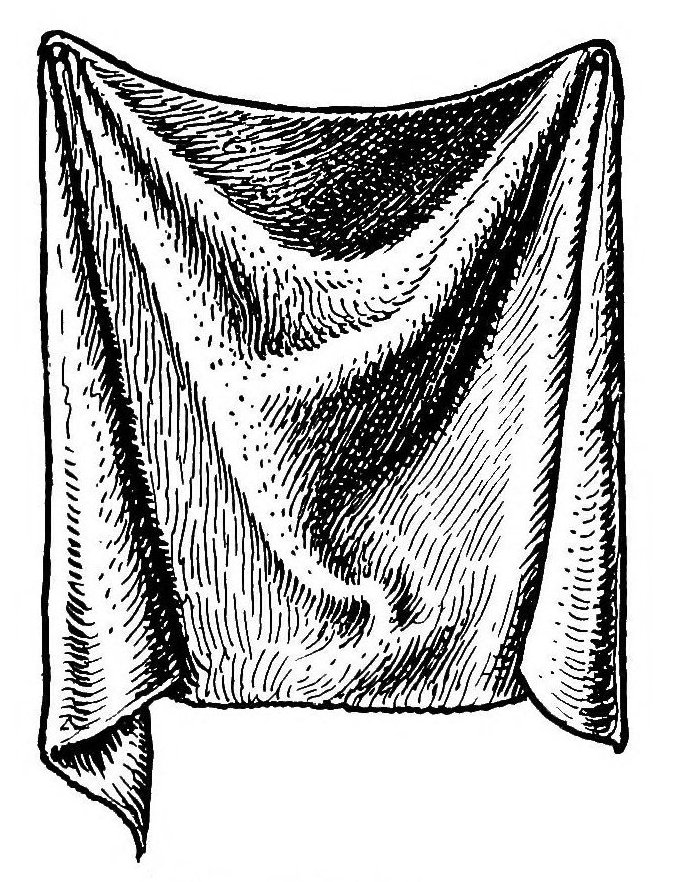 |
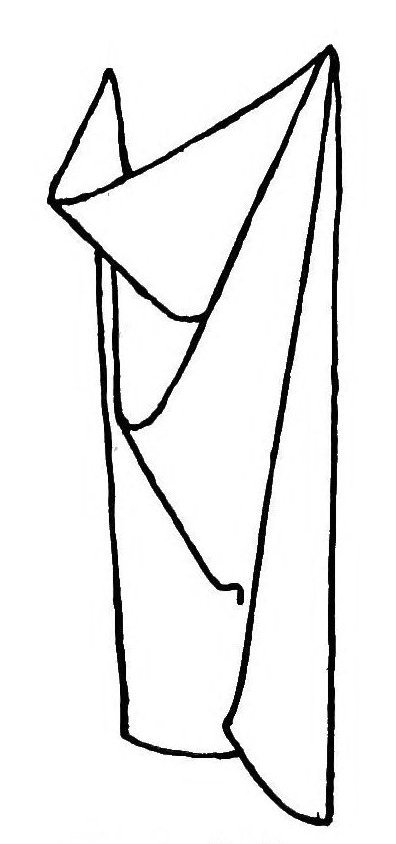 |
| Fig. 4.—Front view. | Fig. 5.—Profile. |
| Drapery suspended from two points. | |
The amount of reflected light will, of course, depend upon the degree of projection of the folds, the amount of light received, and upon the near proximity of other folds to which light can be reflected.
Upon referring to the study of a standing figure by Sir Edward Poynter (page 12), which is really a study of drapery suspended from two points, since the mass of folds starts from the left shoulder of the figure, falls into festoons, and is caught up on the right arm and wrist, it will be seen that precisely the same principle is demonstrated. Indeed, the principle of drapery folds under these conditions never varies, and the folds can always be counted upon to behave in a similar way.
Composition of more complex series of foldsFig. 6 is an example of a larger piece of drapery, which offers a more complex series of folds than the one we have been considering, but still not so complex as that which is stretched upon so varied a form as the human figure. It will be observed that when the drapery is ample the lines take the form of two opposing systems, radiating from and dominated by the points of support: the lines or folds of the drapery answer each other. This answering is caused by the breaking of the fold in the simple festoon at or about the centre, and breaking alternately on one side or the other.

STUDY
(By Sir E. J. Poynter, P.R.A.)
Fig. 7 represents the theory of all foldings of drapery hanging from two points, but in actual practice, from accident or other cause, the folds become a little more varied.
 |
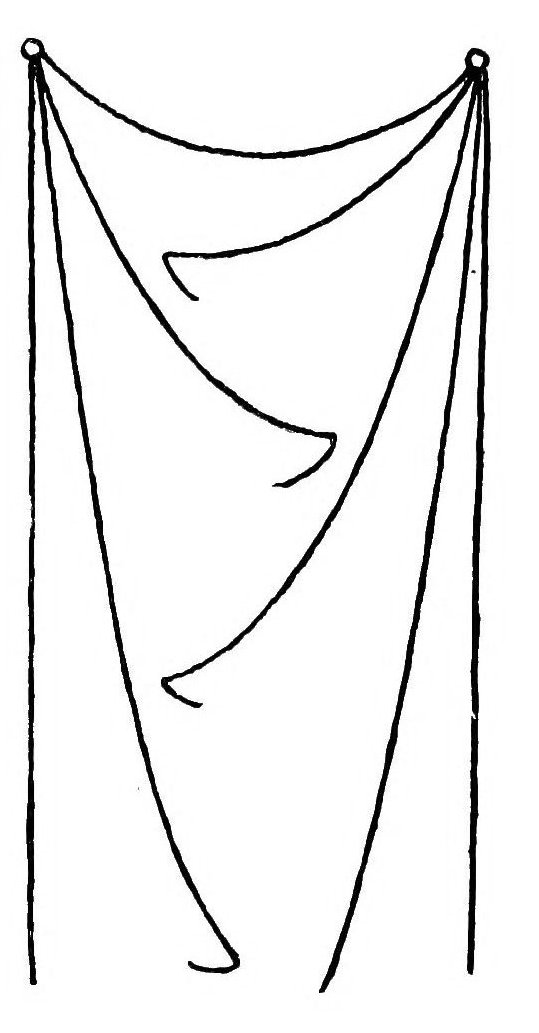 |
| Fig. 6. | Fig. 7. |
| Drapery suspended from two points. | |
The next point to be considered is the character of what may be called the eyes of the folds. These vary with the kind of material employed. Character of folds in different materials In a soft silk the forms are rounder, softer, and the folds more continuous, gentle, and undulating (Fig. 8). In a hard silk they are sharper, and the folds break more suddenly (Fig. 9), the general effect being more angular. Satin partakes somewhat of the character of hard silk, though the folds are somewhat less sharp. The beautiful study of a satin dress by Sir Edward Poynter gives the sheen of satin admirably, and expresses the character of the folds: no better example could be given. The general effect of such a material as silk or satin, with its numberless reflections, depends so much upon its surroundings and the angle of the material to the light that it must be studied from nature: no general system of light and shade and effect could be formulated. In a heavy woollen material the folds are larger, simpler, and the eyes have a squareness, and even a doubleness of character (Fig. 10). In a light muslin the general effect is creasiness and crinkliness (Fig. 11). Velvet is the richest of all materials, and suitable to offices of state and to persons of great distinction.

STUDY OF A SATIN DRESS
(By Sir E. J. Poynter, P.R.A.)
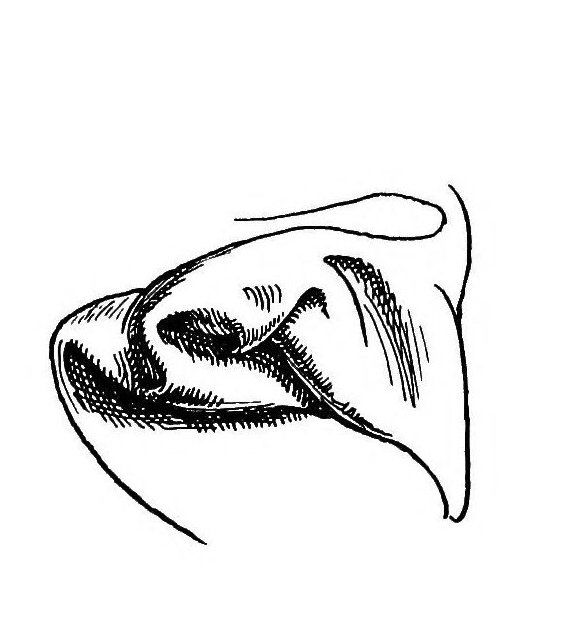 |
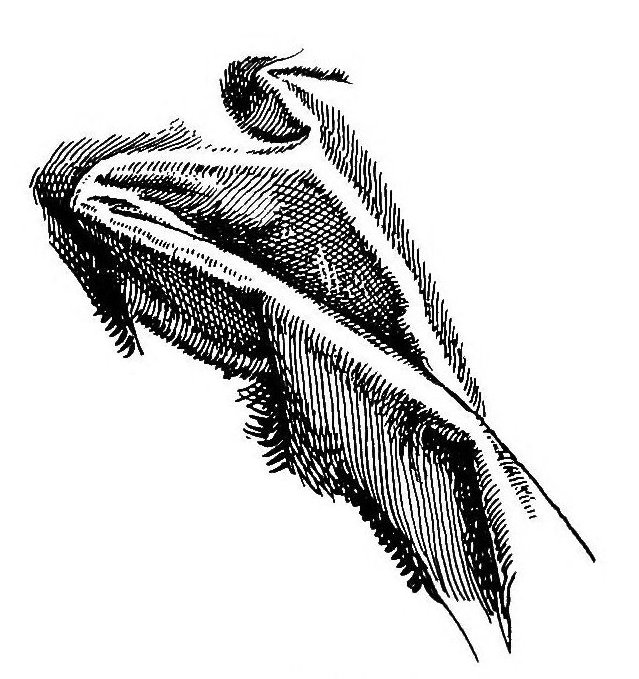 |
| Fig. 8.—Soft silk. | Fig. 9.—Hard silk. |
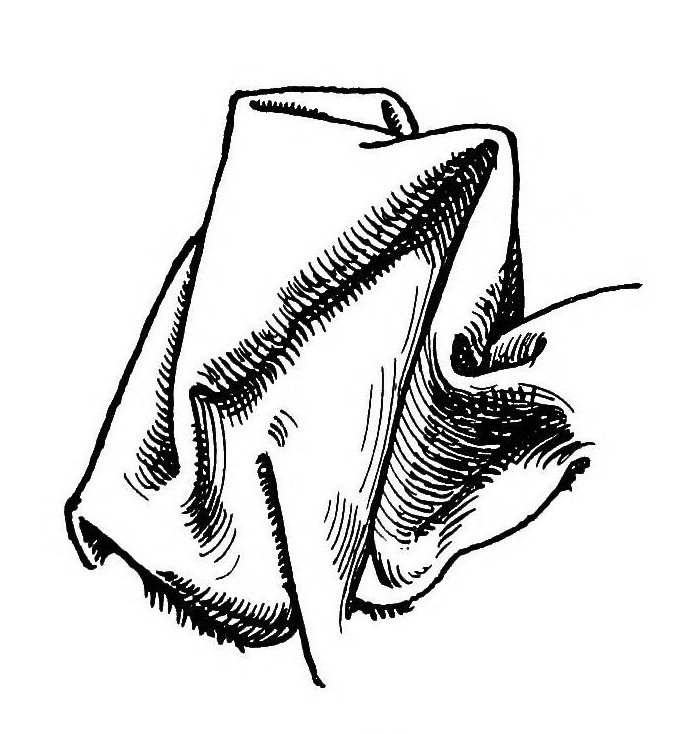 |
 |
| Fig. 10.—Felt. | Fig. 11.—Indian muslin. |
In connection with the foregoing, Sir Joshua Reynolds may be profitably quoted. He says, in his fourth discourse: "In the same manner as the historical painter never enters into the details of colours, so neither does he debase his conceptions with minute attention to the discriminations of drapery. It is the inferior style that marks the variety of stuffs. With him the clothing is neither woollen nor linen, nor silk, satin, or velvet—it is drapery; it is nothing more." It is no doubt true that some of the greatest painters—Leonardo, Raphael, Michael Angelo—did not concern themselves with these nice discriminations; but it should be remembered that since the time of Sir Joshua the English Pre-Raphaelites have amply demonstrated the fact that great Art is not incompatible with the closest attention to the details of nature.
TurnoversAnother most important matter is in the edges and turnovers of the drapery. These should always be emphasised, especially in decorative work, as such emphasis of the edges materially assists in composition of line, and the turnovers give a richness of decorative effect which may be further emphasised by the introduction of a different colour from that of the upper side of the material.
The illustration (Fig. 12), which is from a fifteenth-century brass, is a curious example of a false treatment of turnovers. The under side of the cloak is ornamented with ermine, and the shapes of the turnovers as a consequence are emphasised, while the dress and upper side of the cloak being of the same decorative value the general effect is that of a distorted figure. Mistakes of this kind are exceedingly rare in old work, and the illustration is here given as an example of what to avoid.

Fig. 12.
Monumental Brass, showing
false use of turnovers.
If drapery be placed upon an irregular object, such as the human figure, it will necessarily rest upon, or hang from, its most important points, which will form the points of support, and the drapery will take the form of radiating folds starting from and dominated by those points of support. In an upright figure the folds will either fall perpendicularly from the points of support or take the form of waves or festoons according to the action of the figure.
The points of supportPoints of support are of two kinds—primary and secondary. A primary support is one from which the drapery mainly hangs, as from a shoulder, or, as in the accompanying illustration, from the back and head. A secondary support is produced by any eminence of the body sufficiently prominent to push the drapery out or influence its form.

STUDY OF A KNEELING FIGURE

Fig. 13.—Kneeling figure, showing points and areas of support.
In the accompanying diagram (Fig. 13) the areas of support are defined by the dotted lines, and these are the only parts in which the figure asserts itself. The rest of the figure does not really influence the drapery at all.
In the half-tone illustration given of a kneeling figure a heavy material (felt) is employed. The system of folds is, therefore, extremely simple, and the principle of radiation not so marked as it would be in a lighter stuff.
Fig. 15 is a similar kneeling or suppliant figure by Giotto from the composition of the "Raising of Lazarus" in the Arena Chapel at Padua. It is a very good example of the austere dignity and refinement of this artist's work, and illustrates extremely well the principle of radiation from and to the areas of support. The areas of contact of the drapery with the figure are similar to those of the preceding illustration, with the exception that he has suggested the whole of the contour of the thigh to the knee, so as to express the action of the figure more completely. In this figure the principle of composition of line is slightly emphasised, although the drapery is perfectly natural. There is an element of design in all old work, and properly so, and especially so in the works of the greater artists.

STUDY FOR ANDROMACHE
(By Lord Leighton)

Fig. 14.
Standing Figures, showing areas of support, and draped.
To further illustrate the manner in which the figure asserts itself in drapery, a figure clad in a light clinging material is given (Fig. 14). The areas of support, in this instance, are on the left shoulder, the right forearm, the breasts, the abdomen, the left hip, the right thigh, and the upper portion of the leg. In such light material the contours of the figure assert themselves much more strongly than they would in a heavier material, and the folds radiate from the points where the drapery is gathered up, to the areas of support.

Fig. 15.—Kneeling figure. By Giotto. Arena Chapel, Padua.
If the drapery be drawn upward the system of areas or surfaces of support will be exactly reversed, and will be on the under side of the masses of the figure instead of the upper (Fig. 16), the folds radiating from the points where the action takes place, to the bases or areas of support. In the accompanying illustration
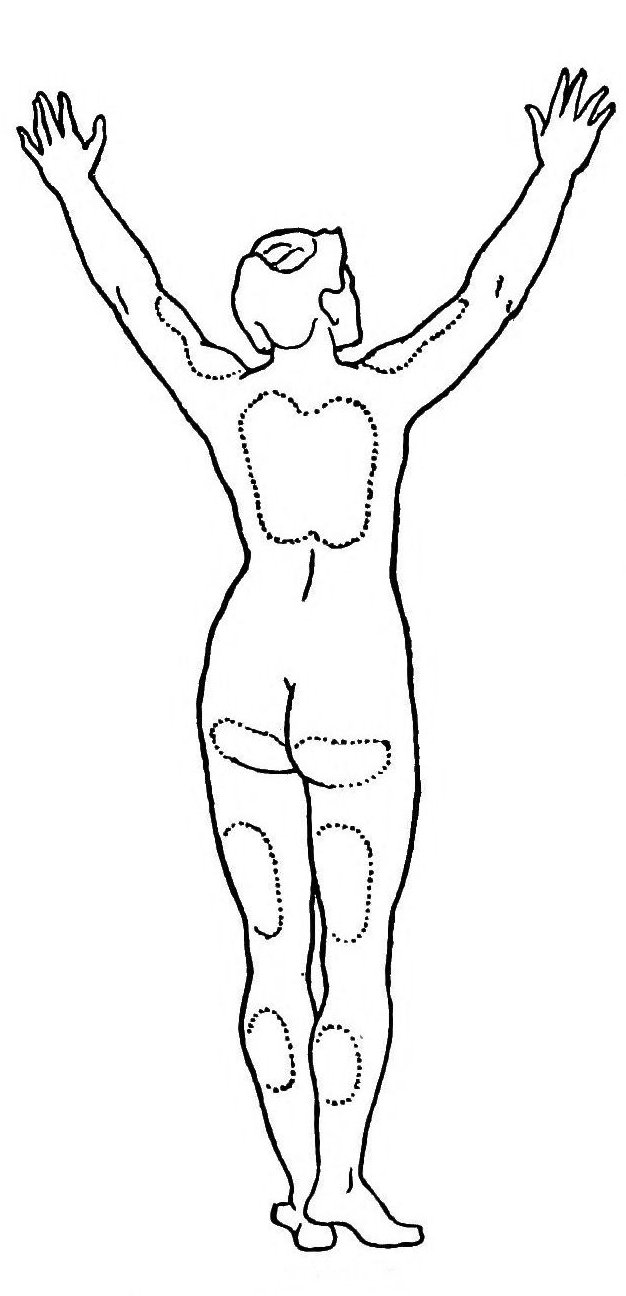 |
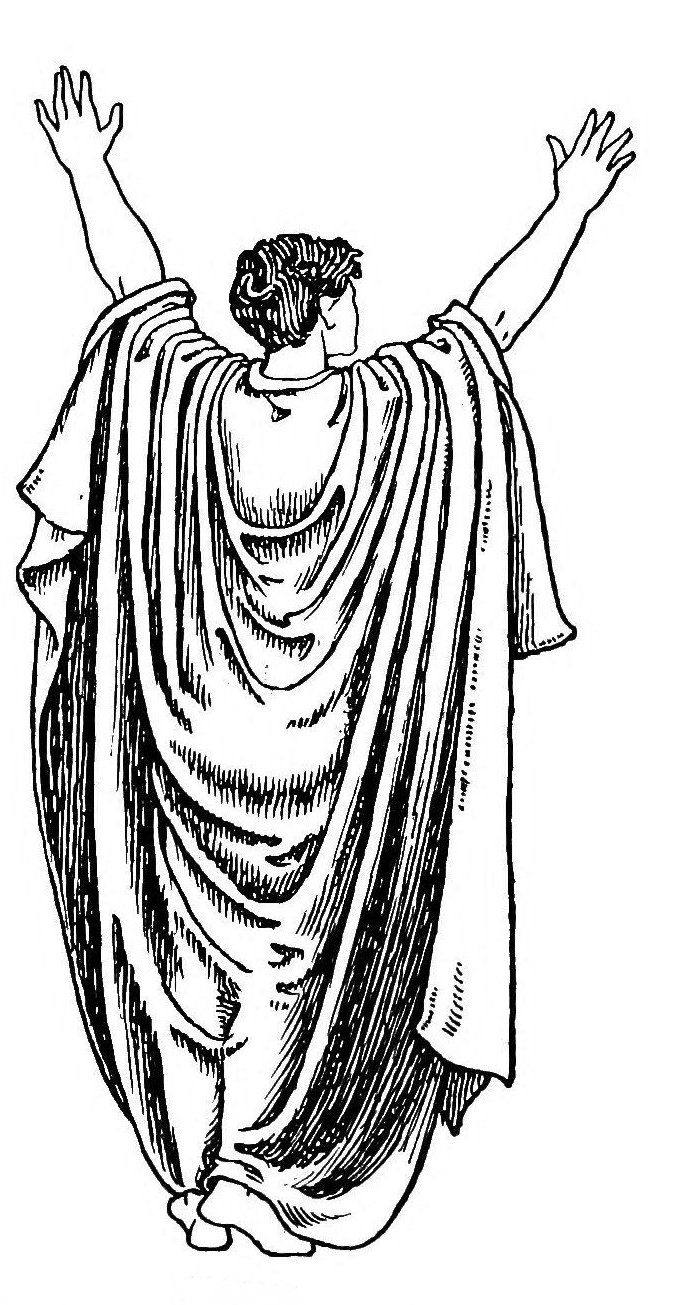 |
| Fig. 16. | Fig. 17. |
| Drapery drawn upward. Figures, showing areas of support, and draped. | |
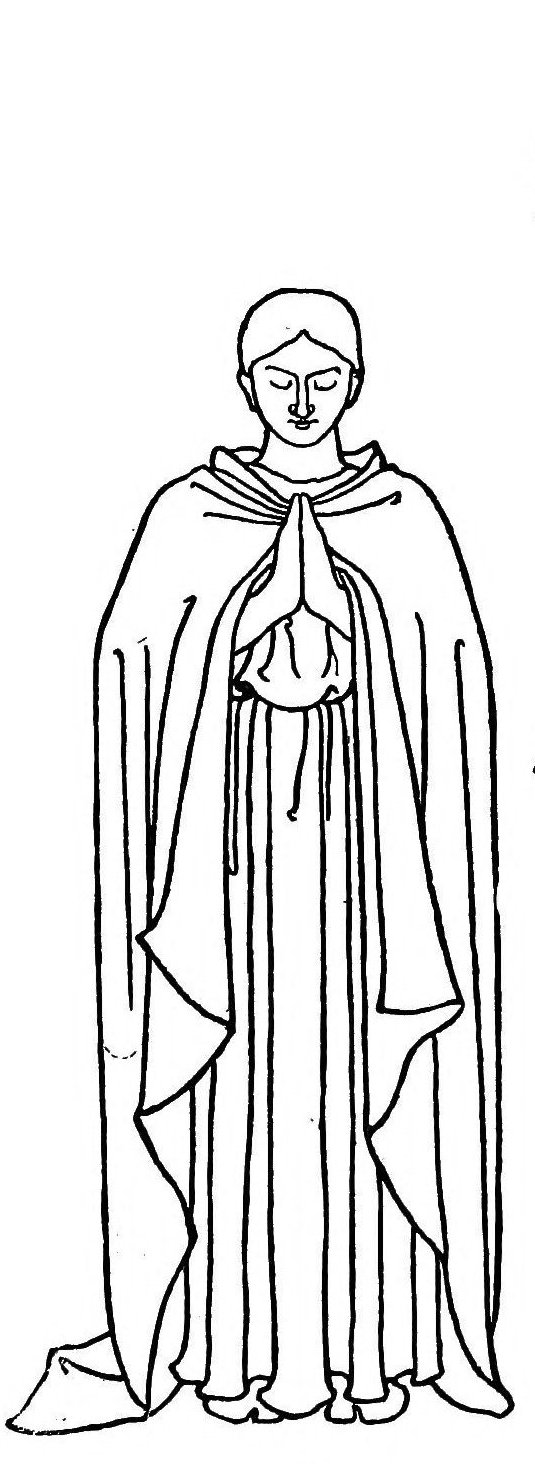 |
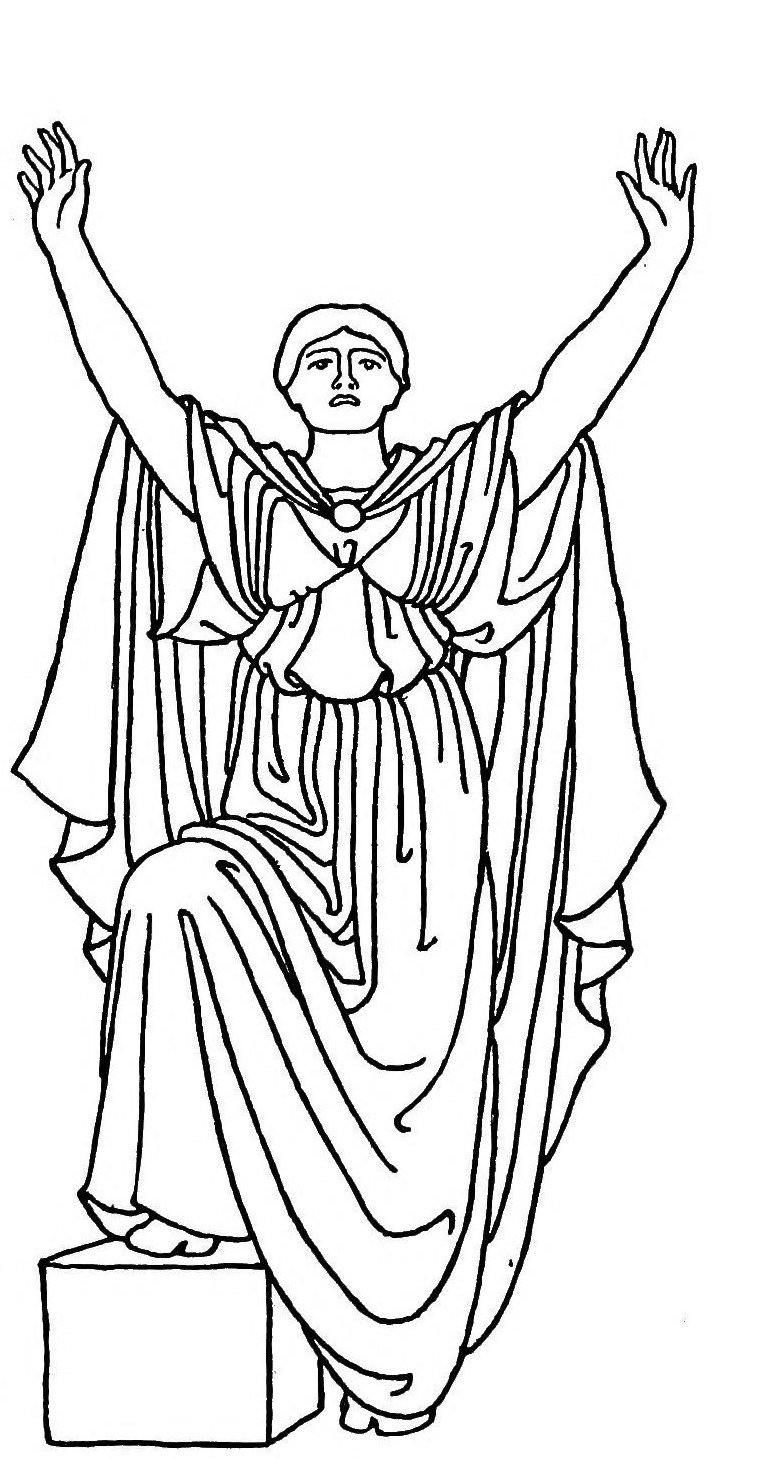 |
| Fig. 18. | Fig. 19. |
| Drapery drawn upward. | |
(Fig. 17) the drapery is drawn up about equally from the shoulders, and the lines of the drapery form a more or less complete series of festoons. In other words, the shoulders form a pulley, and the areas marked by dotted lines on the diagram of the nude figure form the points or areas of resistance of the drapery.
Figs. 18 and 19 represent a figure in a standing reposeful attitude, and the same figure with the arms and right leg upraised. In each instance the principal points of radiation are the fibula at the pit of the neck and the cords round the breasts and waist. In Fig. 19 a secondary system of radiation is formed by the raising of the knee, the drapery forming festoons between the upraised knee and the left hip, the greatest number of folds lying in the hollow between the thigh and the body of the figure.
It will be seen by referring to the illustration that the drapery behaves in a regular and systematic way, both left and right side of the figure being practically the same, with only sufficient difference to prevent monotony. The cast is an ordinary and natural cast of drapery, and not at all arranged.

Fig. 20.—Byzantine Mosaic. Ravenna.

Fig. 21.—St. John. Perugino.
In the figure standing at ease—i.e. with the weight upon one leg and the other slightly bent—the folds of the drapery will always fall perpendicularly from the hip upon which the figure rests, and radiate generally towards the opposite side of the figure, a principal fold radiating to the knee which is pushed out. The leg which is bent, from the knee upwards, Drapery of medieval MSS. will always assert itself, and the form of the leg, especially at the knee, should, in every instance, be clearly defined. The illustration given from a Byzantine mosaic at Ravenna admirably illustrates this law, which is universal both in Art and in Nature. In this instance the drapery of the outer garment is caught up over the left arm, and further emphasises the law of radiation from a given point. Byzantine mosaics are admirable for purposes of study, as the material of mosaic does not favour the introduction of detail. The figures are, therefore, designed with great simplicity and care.
In the earlier mediæval manuscripts this principle of emphasising the form of the thigh, and the radiation of the folds from the one hip to the opposite knee, was reduced to a convention. (See Fig. 22, which is from an Anglo-Saxon MS. in the British Museum, and is not an isolated example but is typical of the work of that period.) And here let it be stated that the word convention is not necessarily used, either in this or other instances in this work, in a derogatory spirit. Indeed, the whole history of Art consists in the setting up of a convention, that convention lasting for a longer or shorter period, to be supplanted in turn by another convention or set of conventions. The illustration in question is, no doubt, somewhat archaic, but it admirably serves its purpose; the drapery fulfils all the conditions of radiation from points of support, and the figure is perfectly natural in idea and intention. Most of the illuminated MSS. of this period, as, indeed, much of the mediæval decorative sculpture, were turned out in the regular course of work without any, or with only a very casual, reference to nature, the artists simply adopting the conventions of the time.

Fig. 22.—Anglo-Saxon MS. British Museum.
In the figure of St. John by Perugino (Fig. 21), which is a typical example of this artist's somewhat monotonous grace, precisely the same principles are observed. The crossing over of the lines of the drapery of the outer garment is an invariable rule with Perugino. "This crossing over has an important use: it counteracts the inevitable parallelism of lines in a group of standing figures—a parallelism which is still further concealed or counteracted by the great horizontal folds which so frequently envelop the waist of the figures of Perugino—an artifice which Raphael was wise enough never to abandon."[1]
Perugino's figures can be reduced to four or five stereotyped poses and casts of drapery, the same figures, with very slight variation, constantly recurring in his compositions, and enacting different parts; some female saint will, by the addition of a long beard and, perhaps, a bald pate, instantly do duty as prophet or apostle; and Perugino continued to play variations on these few tunes (good tunes, however) to the end of the performance, which, in his case, was a very long performance, as he lived to a ripe old age.
Notwithstanding the foregoing remarks, this figure of St. John well holds its own as a composition against the Byzantine figure opposite, which is saying a considerable deal. Perugino's work is of the greatest service to the student, as his methods and devices were so uniformly simple and transparent.

Fig. 23.—Page from Dürer's "Apocalypse."
|
Moody. "Lectures and Lessons on Art." |
In the drapery of seated figures the chief points of support will, of course, be the knees, the areas of support extending along the upper portion of the thigh. The front view, in principle, is exactly similar to that of drapery hanging from two points: it is, in fact, drapery hanging from two points. The folds fall perpendicularly from the knees, and a series of more or less regular festoons is formed between. In the illustration given opposite—a study for a figure of Neptune—which is a perfectly natural cast of drapery upon a living model, the folds fall with singular regularity, the zigzag turnovers on either side being almost identical. In Byzantine and early Gothic draperies this principle was reduced to a convention, and the figures were drawn upon a regular principle of festooning between the knees, and the knees made the starting-point of a series of radiating lines.

STUDY FOR NEPTUNE
(By G. W. Rhead)
 |
|
| Brogi photo] | [Vatican, Rome |
| JURISPRUDENCE (By Raphael) |
|

DIES DOMINI
(By Sir E. Burne-Jones)
There is no doubt that a very good system of decorative drapery may be built up, without direct reference to nature, if the law of composition of line and the decorative principles are observed. "If you take any figure, and arbitrarily fix a point of support, provided it is on a prominence, you may set out the foundation of a very respectable composition of drapery by drawing lines from it in every direction."[1] It is always a moot point as to the precise degree of naturalism which should be introduced; but it is certain that in any cast of drapery, even on the living model, much that is accidental or irrelevant must be eliminated: it is the office of the artist to simplify, to arrange, to digest.
Drapery on the decorative principleThe fine composition of "Dies Domini," by Sir Edward Burne-Jones, is an excellent instance of drapery done on the decorative principle entirely, and without any direct reference to nature. It is an example of a number of similar compositions by this master. The principle was derived from a study of the earlier architectural work, and the value of these compositions lies in the frank recognition of the decorative principle. It is, in fact, the simplest and most direct expression possible, of the law of composition of line.
In the interesting little study by Fra Angelico the principle of radiation from a given point is strongly emphasised—a principal fold between the knees, and the radiation of the folds from the knees to other points of support. This little study, doubtless, supplied the material for a number of Fra Angelico's seated figures, as Fra Angelico—indeed, most of the Italian artists—worked upon a regular principle: figures in a similar pose offered little variation in the folds of the drapery. In two pictures by this master, the "Coronation of the Virgin" and the "Annunciation," in the same building in Florence, the Convent of San Marco, the drapery of the lower portions of the figures is almost identical, and was evidently done from the same study.
The figure of "Isaiah," by Michael Angelo, is an admirable example of the treatment of the lower portion of the drapery of a seated figure. Variety is arrived at by means of crossing the feet; a principal fold starts from the right knee and runs up the centre of the figure to the waist, and serves to balance the composition. The cloak, which is pinned at the shoulder, serves to amplify the figure as well as to complete the composition. Indeed, the whole design illustrates to a remarkable degree this artist's great power over composition of line.

STUDIES FOR THE LAST JUDGMENT
(By Fra Angelico)
 |
| [Sistine Chapel, Rome |
| ISAIAH (By Michael Angelo) |

STUDY FOR A PROPHET
(By Sir E. J. Poynter, P.R.A.)
The arrangement of drapery upon a seated figure must, of necessity, present a smaller degree of variation than that of standing figures, as the action of the figure is more restricted. The principle will necessarily be that of a system of radiation from the knees. The fine study of a prophet by Sir Edward Poynter is an example of a less conventional arrangement of a decorative seated figure, and is, moreover, one of Sir Edward Poynter's most successful studies. It is a study in black and white chalk on a dark red paper.
|
Moody. "Lectures and Lessons on Art." |
The folds of the sleeve, almost any sleeve, in whatever position the arm be placed, make a complete composition in themselves. The system is that of radiation from the bend of the arm, where the greatest number of folds will be, the lines of the folds usually following the contours of the limb (Figs. 25, 27).
If the arm be upraised or extended a series of folds will start from the point of resistance—the arm-pit—a principal fold crossing over to the point of support on the upper portion of the forearm (Figs. 24, 26).
The illustration given, by Leonardo da Vinci, is not only an excellent example of this master's unrivalled draughtsmanship but is absolutely perfect in composition of line. The same easy rhythm of composition is observable in the example from Raphael (Fig. 28).
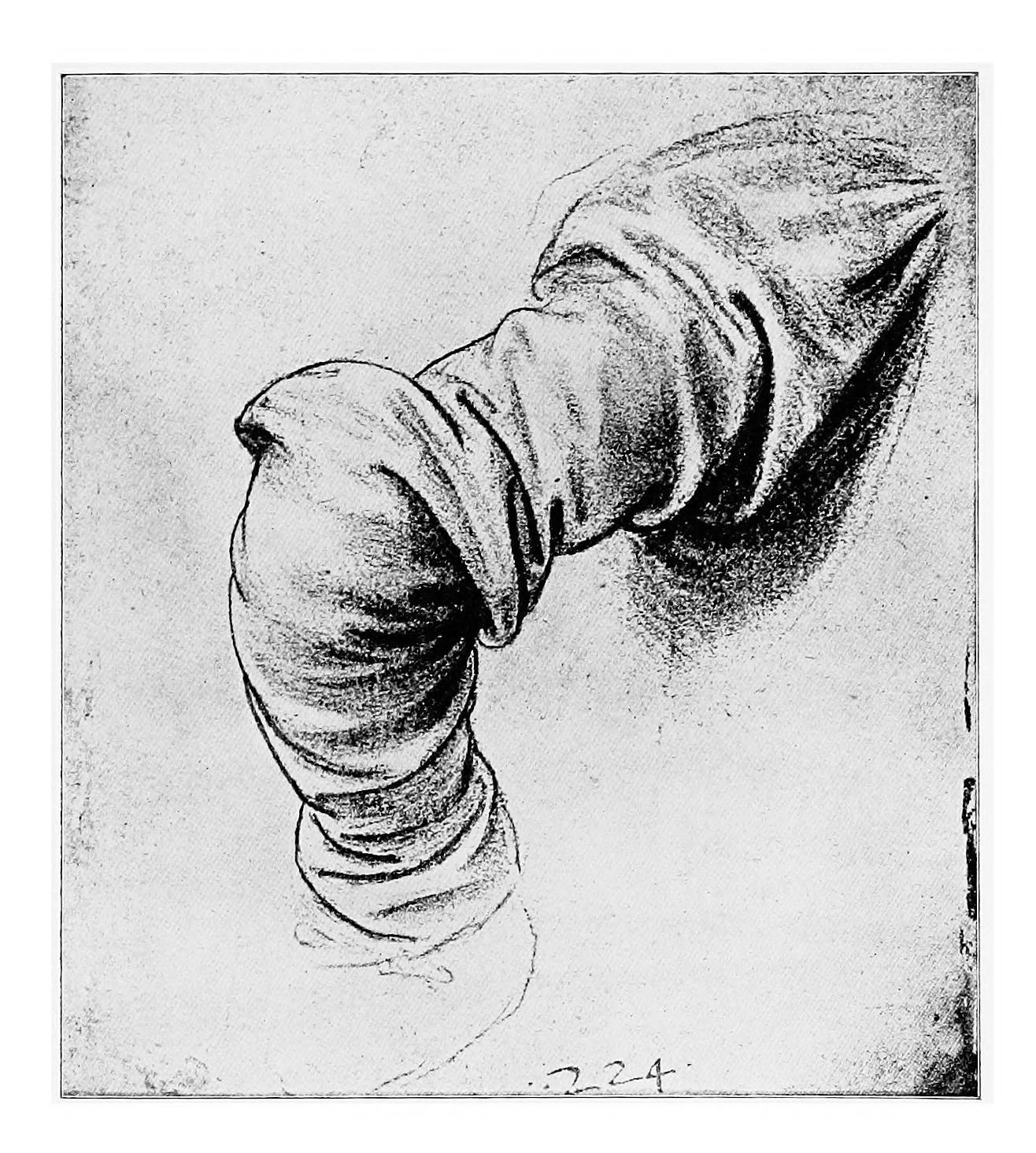
STUDY FOR A SLEEVE
(By Leonardo da Vinci)

Figs. 24-27.—The folds of the Sleeve.
Fig. 29 is from a fragment of fresco in the Wynn Ellis collection in the National Gallery. It is attributed to Filippino Lippi, and is most probably by him, as it possesses all the characteristics of Filippino's work. The edge of the sleeve is made to form a large turnover, and the folds are thrown transversely and loosely across the arm, so as to give a greater variety than would be possible in a plain sleeve. This device of throwing larger folds, or overlapping of drapery, at the wrist, elbow, or shoulders is characteristic of this school of painters—Fra Filippo and Filippino Lippi, Ghirlandaio, Botticelli, Lorenzo di Credi, and others. It is in most cases suggested by, and in many cases is an actual representation of, dresses of the period. It was reduced to a convention in the work of some of the more decorative artists, and in many majolica plates, etc.

Fig. 28.—Sleeve from Raphael's St. Cecilia.
Loose sleeves
Loose sleeves should always be ample. Nothing looks so mean as a sleeve which is neither a loose nor a close fitting sleeve. A piece of calico 30 inches by 30 inches doubled and hemmed up the side, giving a width of 15 inches, makes an admirable sleeve, and allows for a full turnover at the wrist, as well as ample folds.

Fig. 29.—Fragment of Fresco, National Gallery.
Indeed, ampleness and fulness of the folds is a quality which should never be lost sight of, especially in depicting persons of distinction.[1]
In the example given of the figure of the Deity from Dürer's "Apocalypse" (Fig. 30), picturesque richness of effect is carried to its utmost limit. Nothing can exceed the strength, variety, and richness of the turnover of the loose sleeve of the right arm, the edge of which, it should be noticed, is strongly emphasised.
In full sleeves the system will be that of folds falling from the shoulders to the bend of the arm and wrist, and over the arm. The folds of all sleeves take a more or less diagonally spiral form from the body, and the spirals become more marked as the arm is turned inward.
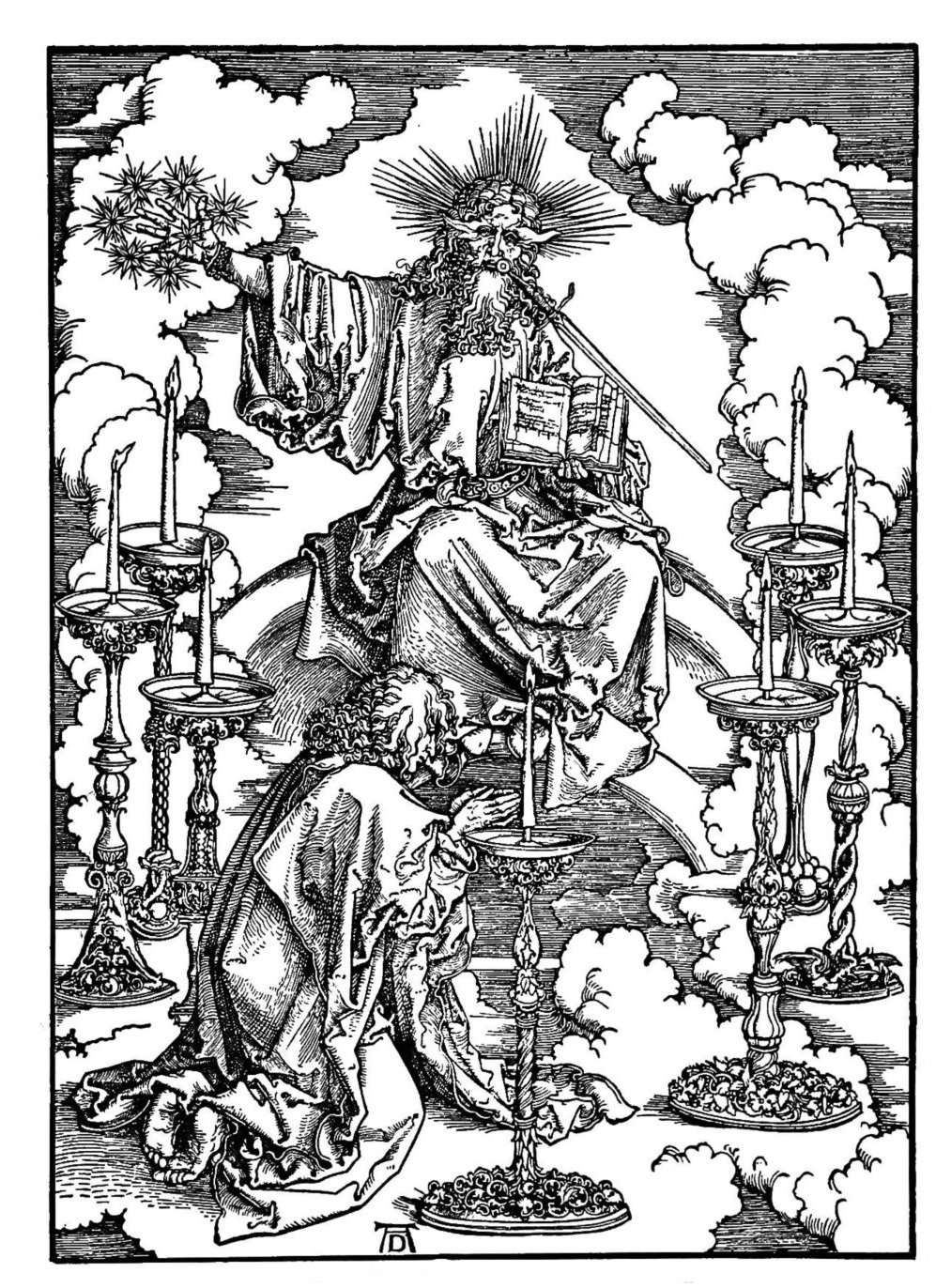
Fig. 30.—Page from Dürer's "Apocalypse."
In the single example given of Dürer's studies (page 42), which is one of Dürer's most convincing drawings, the same principles are observable, although the study in question is a purely naturalistic drawing in which the law of composition of line is not particularly insisted upon.

STUDY OF A SLEEVE AND DETAILS
(By Dürer)
|
"The robes of state are always made large and full, because they give a grandeur of appearance suitable to the offices of greatest distinction. The judge's robes have an awful dignity given to them by the quantity of their contents, and when the train is held up there is a noble waving line descending from the shoulders of the judge to the hand of his train-bearer. So when the train is gently thrown aside it generally falls into a variety of folds which again employ the eye and fix its attention." "The grandeur of the Eastern dress, which so far surpasses the European, depends as much on quantity as on costliness. In a word, it is quantity which adds greatness to grace." "Quantity, or fulness of dress, has ever been a darling principle."[2] |
|
Hogarth. "Analysis of Beauty." |
Classic costume has, at all subsequent periods, been accepted by artists for the draping of ideal or decorative figures, on account of its extreme simplicity and refinement, and the opportunities which it affords of varied composition of line. It would seem desirable, therefore, at this stage of the work to give a short survey of the principal articles of dress worn by the classic nations, the leading facts of which are taken from Hope's "Costumes of the Ancients."
It should, however, be borne in mind that our knowledge of classic drapery is almost entirely derived from sculpture. Greek painting is practically non-existent, except on vases, where drapery is represented in pure line. The continuous, pipey folds of Greek sculpture are proper to the material and method of sculpture; but in such a totally different art as painting a different and, perhaps, broader treatment is not only allowable but may even be desirable.
The qualities of classic draperyThe great refinement and beauty of form, the diversity of the folds, and the inexpressible elegance and endless variety in the throw of the drapery displayed in the finest classic work make an intimate knowledge of it a necessity to any artist who would attempt ideal work.
The costume of the Greeks and Romans is essentially the same, with the exception of the toga, which is particularly a Roman garment. For, as the Greeks, during the greater part of the Roman period, were the artists and artificers of the Romans, the costume of the latter insensibly partakes of the character of the former.
The tunicThe chief article of dress, of both men and women, and worn next to the skin, was the tunic. This was made of some light material: in the earlier period it was made of wool, in later periods of flax, of flax mixed with silk, and of pure silk. It was practically a simple bag with the two ends open, two squares of about 1¾ to 2 yards sewn together at the sides, often sleeveless, with two openings for the bare arms, and closed over the shoulders by means of clasps or buttons. This tunic was worn by females either quite loose or confined by a girdle, which was either worn tight round the waist or loosely slung round the loins. Often a second girdle was worn, and the folds of the drapery drawn up between, and allowed to hang loose over the girdle. A very usual way of confining the tunic was by means of a light cord thrown over the head, with the loop hanging at the back, the two ends passing crosswise between and underneath the breasts, passing through the loop at the back and being tied round the waist at the front, the folds of the drapery being drawn up so as to conceal the cord.
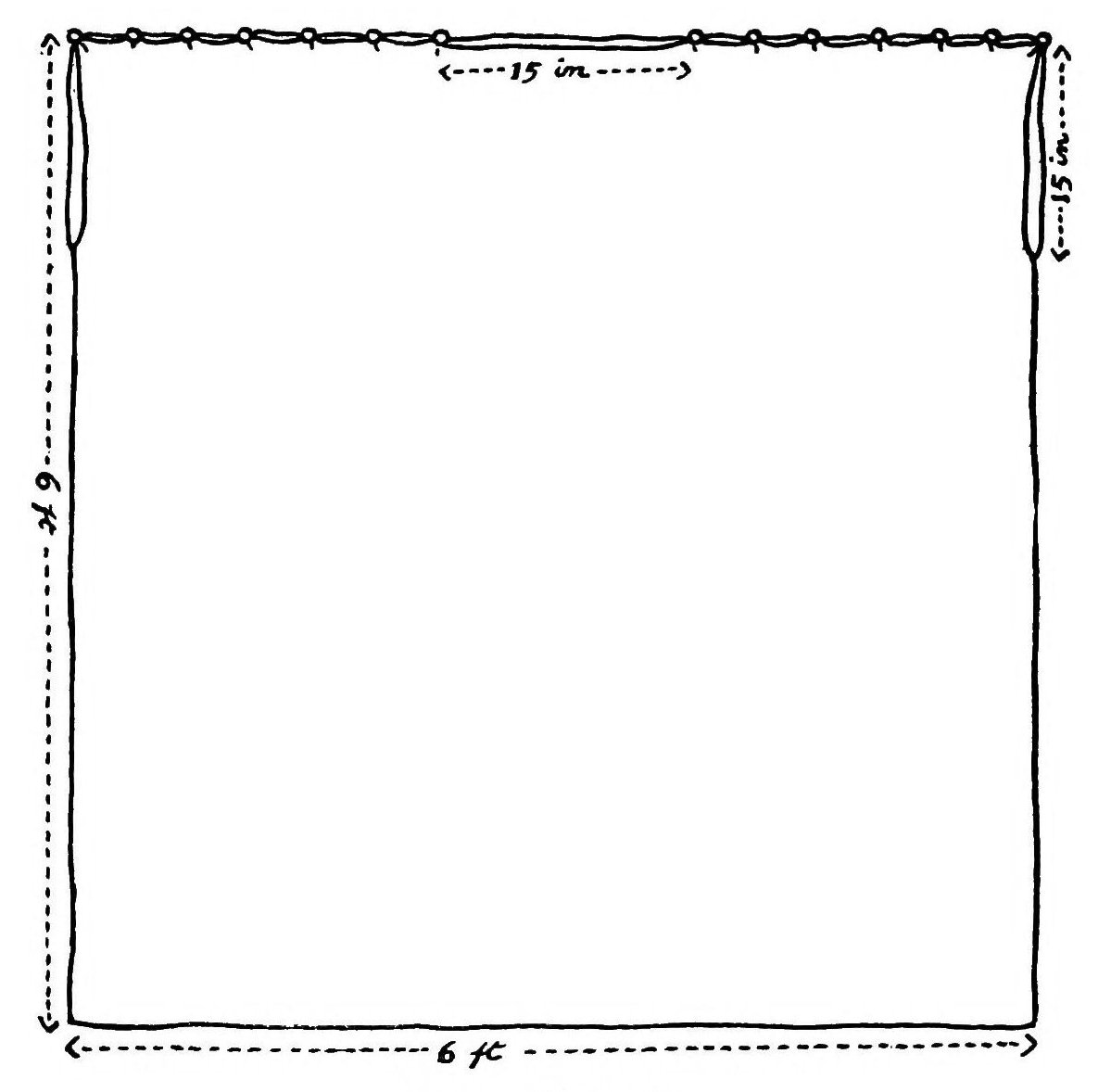
Fig. 31.—The Tunic.

Fig. 32.—The Tunic twisted and folded up when not in use.
The Greek tunic is made square, so as to ensure sufficient amplification of the folds. Either mull muslin, Indian muslin, or Indian silk will give very good folds. The sides should be sewn up, leaving about 15 inches at the top for the passage of the arms. The buttons should be placed at regular intervals along the top, leaving a space of about 14 inches for the head and shoulders. The top and bottom should be neatly hemmed (Fig. 31).
It is a common practice for artists to twist the whole garment into a tight knot when not in use, so as to give the folds a creasy character similar to that which is suggested by the best Greek sculpture. It also imparts a sense of life and sparkle to the material, and the play of light on the folds is more varied especially in silk (Fig. 32).
The tunic was often decorated with sprigs, spots, stars, etc., over the whole field of the stuff, with rich borders of frets, scrolls, meanders, etc., round its edges. In times of mourning the tunic was black, often ornamented with grave patterns or diapers.

Fig. 33.—From Hope's "Costumes of the Ancients."
Over the tunic a second garment was often worn, intended as an additional covering to the upper half of the person. It is a species of bib, composed of a square, or more often oblong, piece of stuff, folded double, and worn in such a way that its centre came under the left arm, and its two ends hung down loose over the right arm and reached to the hips. It was secured on the shoulders by means of two clasps or buttons. It should be added that in this, as well as in other garments of the Greeks and Romans, the corners were generally weighted with little pieces of lead, etc., to ensure a better falling of the folds (Figs. 33, 34, 35).
The PeplumThe peplum constituted the outermost garment, and was the Greek form of toga. It was common to both sexes, and when very long and ample, so as to admit of being wound twice round the body, first under the arms, and the second time over the shoulders, it assumed the name of diplax. It was drawn over the head in rainy weather and in times of mourning (Fig. 34).
The peplum was never fastened on by clasps or buttons, but was kept in its place by means of its own involutions. The different ways of throwing the peplum formed endless combinations and compositions of line; in fact, the different degrees of simplicity or of grace exhibited in the throw of the peplum, as well as the quality of the material, indicated the degree of rusticity or refinement or the social position of the wearer. A piece of light material, 4 yards by 2 yards, will enable the student to form the leading combinations of the peplum, and will offer numerous suggestions of composition of line and design.
Archaic Greek draperyThe earliest Greek period exhibited the greatest formality in its arrangement. The folds of the drapery consisted of innumerable parallel pleats forming a regular series of zig-zag ends or turnovers, which were accomplished by the use of heated irons. The accompanying illustration (Fig. 34) is a very good example of the old style of dress. The tunic is of a light creasy stuff which, not admitting of broad or easy folds, is closely confined to the body. The principle of fan-like radiation is very marked in the arrangement of the peplum, which is thrown over the right shoulder, the folds radiating from that point. Indeed, the whole character of this period, both as regards costume and the arrangement of the hair and beard, is one of extreme formality and regularity.

Fig. 34.—Archaic Figure. From Hope's "Costumes of the Ancients."
In addition to the before-mentioned articles of dress the Greeks wore a simple cloak, called chlamys, fastened over the shoulder or upon the chest by means of a clasp or button. An example of this is seen in the "Apollo Belvedere." The illustration given of a Greek warrior in his travelling cloak is an extremely good example of the simple treatment of drapery, the lines, as usual, radiating from the chief point of support, the fibula or button upon the chest, and a subsidiary system of radiating lines from the elbow, the contour of the figure being shown in the plain portion of the drapery (Fig. 35).
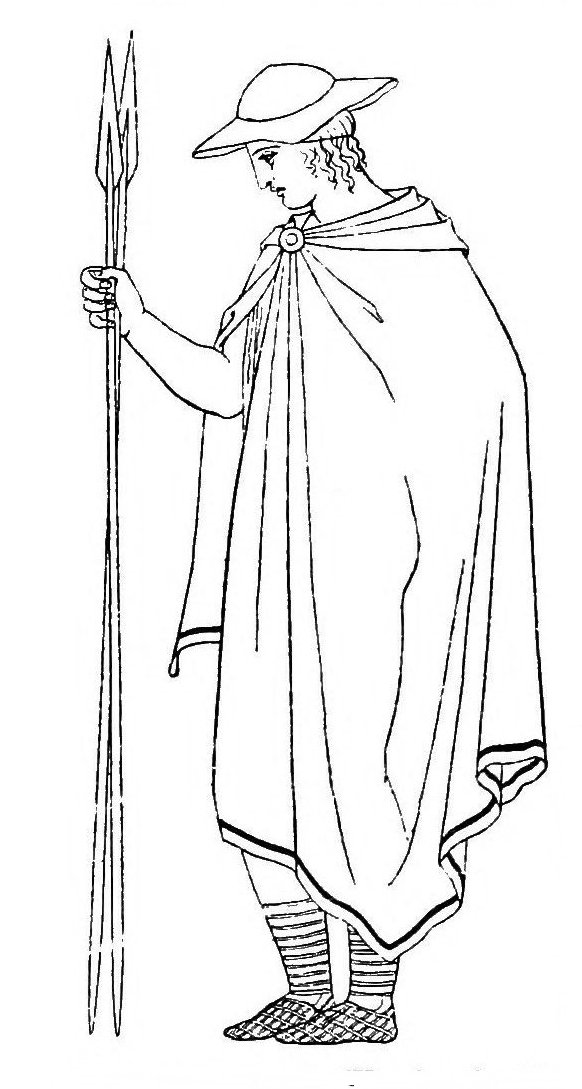
Fig. 35.—Greek Warrior in his Travelling Cloak.
From Hope's "Costumes of the Ancients."
The peculiarly distinctive dress of the Romans, which may be described as their national dress, was the toga. It was worn in its various forms by all classes; in earlier times by both sexes, and by young as well as old. It was first worn without the tunic; indeed, the tunic was of later introduction amongst the Romans than the toga, and was regarded as a species of luxury. The men generally wore short tunics reaching about half way down the thigh; long tunics, being generally regarded by men as a mark of effeminacy, were relegated to women. Love of change and novelty, no doubt, caused the toga to be gradually abandoned by the women in favour of the long tunic and the more pre-eminently Greek pallium. The toga, from motives of convenience, was first abandoned by men of the lower orders, but remained for a long period the distinguishing dress of the patricians; and it was not until the seat of the Empire was transferred to Constantinople that the toga was entirely superseded by the more closely-fitting and generally more convenient pallium.
The probable shape of the toga, and the manner of wearing it, have been the subject of much discussion amongst authorities. Modern research, however, has demonstrated beyond doubt that the toga was nearly elliptical in shape, that it consisted of two parts sewn or fastened together, a complete semicircle and a smaller segment of a circle (Fig. 36), the one part doubled over the other, so as to make the garment a semicircular one (Fig. 37).

Fig. 36.—The Toga opened out.
The dotted lines, A A and B B, indicate
the portions of the garment which are folded upon the left shoulder, first and
second time.
 |
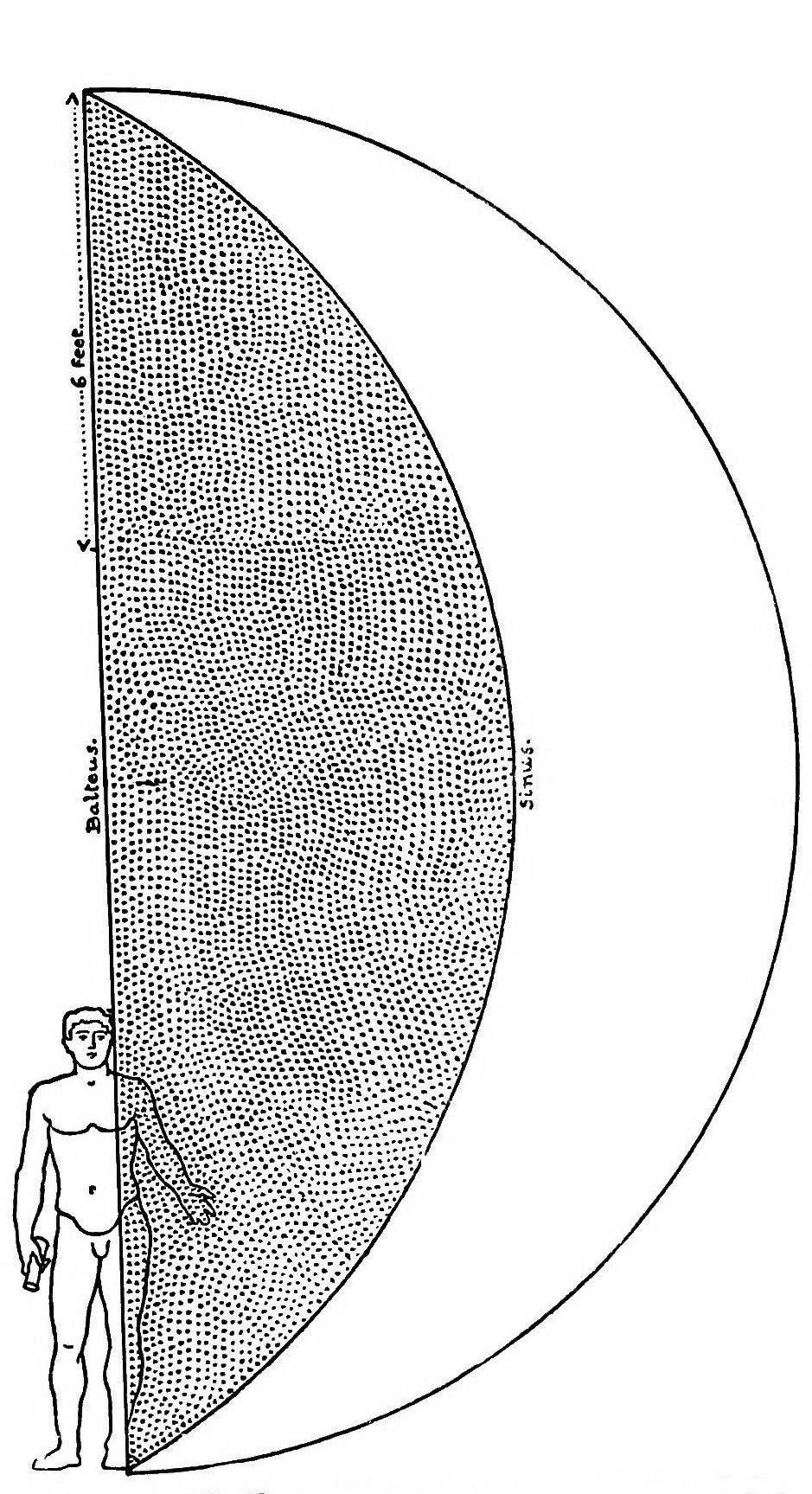 |
| Fig. 38.—Diagram showing the adjustment of the Toga upon the figure. | Fig. 37.—The Toga, folded over, as worn, and shown in its relation to the height of the wearer. |
Dimensions of the toga
The following dimensions, together with the mode of adjusting the garment, are given on the authority of Sir L. Alma-Tadema: The length should be three times the height of the wearer. For a man of 6 feet the garment would measure 18 feet by 9 feet; the width of the smaller portion of the garment should be a little less than two-thirds the width of the semicircular portion.
It should be explained that the three diagrams (Figs. 39, 40, 41) which represent the earlier or Etruscan form were drawn from a small toga 15 feet long by 5 feet wide, placed upon a tall man, in order that the arrangement of folds should be more simple, and the adjustment of the toga be more easily understood by the reader.
Method of adjustmentThe method of adjusting the toga is as follows:—The garment, doubled over so as to form a semicircle, is held by both hands behind the figure, with the round edge downwards. One end of the toga is then placed upon the left shoulder in such a position that the point or extreme edge touches the toes, and practically divides the figure in half (see Fig. 39), care being taken to adjust the folds regularly and evenly upon the shoulder, allowing about three quarters of a yard to fall over the left arm to the wrist. The other portion of the toga is then gathered up in the right hand, brought under the right forearm, and flung across the chest and over the left shoulder sufficiently far for the point or extreme end to touch the ground behind the figure, the right arm being left bare (see Figs. 40, 41). It will therefore be seen that both extreme ends should just touch the ground. It should be stated that these ends or points are usually weighted, in order to ensure a proper falling of the folds. This, as before stated, represents the simplest possible arrangement of the toga; the garment afterwards became fuller in its folds and more complex in its arrangement.

Figs. 39, 40, and 41.—The earlier and simpler form of Toga, showing manner of adjustment.
In the statue of the Emperor Titus it will be seen that the sinus, that portion of the toga which hangs down in front of the body and forms a sweep like the curve of a bay, is much more full and ample than in the preceding illustrations; that further, a system of folds is drawn more or less tightly across the waist, and that from these folds issues a sort of bag or pouch of folds which extends to the left shoulder. This bag or pouch is called the umbo, and is the portion of the dress the adjustment of which the earlier authorities found most difficult of explanation. The matter, however, becomes perfectly simple, like the egg of Columbus, immediately it is demonstrated. The umbo is produced by simply pulling out the mass of folds which were first placed on the left shoulder and allowing them to fall over the folds which are drawn across the chest.
 |
|
| Alinari photo] | [Vatican Museum, Rome |
| STATUE OF THE EMPEROR TITUS | |
The question of fastenings
Some writers have inferred, from the great formality and little variation displayed in its divisions and folds in the statues which have come down to us, that the toga, like modern dresses, was the result of some studious and permanent contrivance, and was kept in its place by means of a series of tacks, pins, or fastenings. This, however, is an error; the toga was most certainly kept in its place merely by the weight of its own folds. Quintilian gives directions to an orator for the management of his toga whilst speaking, which would be scarcely necessary if the art of the tailor had been called into play. Moreover, no traces of any fastenings can be discovered on any existing statue.
The difficulty of wearing the toga gracefully by persons unaccustomed to the garmentThe form of the toga is determined entirely by the spontaneous throw of its folds, and it should be remembered that the little variation observable in the different representations of the toga is due to the wearers becoming accustomed to the garment from long habit and use. Sir L. Alma-Tadema declares that he has only one model who is capable of wearing the toga with anything approaching to ease and grace.
Material of the togaThe material of the toga was wool in the early time, of its own natural yellowish hue; afterwards silk and other materials were used.
ColourThe toga was always of two colours, except in the case of candidates for offices (candidati), who wore it entirely white, and bleached by an artificial process.
The toga picta was ornamented, often with rich Phrygian embroideries, and was worn by generals in triumphs.
The toga prætexta had a broad purple border (see Figs. 39, 40, 41), and was worn by magistrates and by priests, in which case it was pulled over the head, and by persons engaged in sacred rites or paying vows.
The toga, although a most distinctive and characteristic dress, can scarcely, however, from the æsthetic point of view, be considered so satisfactory a costume as the Greek peplum or pallium, and can hardly be said to offer such opportunities for decorative treatment. Firstly, from the multiplicity of the folds of the toga and the comparative heaviness of the dress, the form of the figure is more entirely concealed; and secondly, the toga exhibits several systems of folds, a principal system of radiating folds from the left shoulder, and a subsidiary system from the arm or wrist—a principal system of loops or festoons representing the sinus, and a subsidiary set of festoons which form the umbo, instead of one dominating system of folds, such as, for example, is represented in the illustration from Byzantine mosaic (Fig. 20).
An interesting illustrated article on the toga appeared in the Gazette des Beaux Arts during the year 1874.
Of the various dresses worn by the Romans the hooded cloak (cucullus) may be mentioned. This was made of coarse brown wool, and was worn as a screen against cold and wet.
The Roman tunicThe under-garment of the Roman ladies was a long tunic descending to the feet, called stola, corresponding to the Greek tunic. Over this they adopted the Greek peplum, under the name of palla. This garment, however, was exclusively confined to the gentler sex, and was never worn, as was the peplum among the Greeks, by men.
An important matter in connection with the consideration of classic costume is that of the proportions of a figure itself. Proportion is one of the chief things which make for that rare quality we call style, a quality not easy of definition, but, one which can be perceived and felt. Fortunate, indeed, is that person who possesses this quality as a natural gift, and although it is impossible to lay down any precise rules for its acquisition, yet there are certain practical principles which, when perceived and followed, undoubtedly conduce to that fine air which is observable in all works which can lay claim to this great quality.
In any ideal or decorative work, or work dealing with any heroic character, short, stumpy figures look mean and poor; and there is no costume which takes away from figures Classic costume reduces apparent height of the wearer the impression of height so much as classic. It requires a very tall woman to look tall in a Greek dress. No doubt the absence of any train, such as is common to both mediæval and modern dresses, accounts for this to some extent. At any rate it is well known that a train makes a woman look taller. Both men and women, however, look short in classic costume. One has only to look at the photographs of actors and actresses in classic costume in order to realise this fact very forcibly.
The principle of taperingThe principle of tapering is universal in nature. It is observable in all animal as well as vegetable forms; most marked, perhaps, in trees, in which the greatest bulk is in the trunk, and the branches taper gradually to a fine point. The old artists frankly recognised this principle, emphasised it in their figures, and made the extremities small—heads, hands, and feet. The height of a well-proportioned figure of an ideal character should, therefore, measure 7¾ to 8 heads—the latter number is a good The proportion of Raphael's figures and safe rule. It is true that Raphael rarely exceeded 7½ in his paintings; but it should be remembered that Raphael's work (notwithstanding the fact that it is the present fashion to belittle Raphael) possessed so many fine qualities that his work was fine in style in spite of the comparative shortness of his figures. Burne-Jones sometimes gave as many as 10 heads; but this was for stained-glass windows for Gothic churches, in which everything makes for the impression of height. There is a drawing by Michael Angelo, in the collection of a well-known amateur, of "Christ descending into the Sepulchre," in which the figure, although foreshortened, measures nearly 10 heads, and the hands and feet are equally small. No doubt, in the finished work, Michael Angelo would have modified this; but it is an evidence of his consciousness of the necessity of erring on the side of smallness of the extremities rather than the reverse.
Drapery in motion is certainly more difficult to treat than in any other of its aspects. It is at the same time one of the most important branches of this study, since any composition of a dramatic character necessarily implies movement.
The general tendency of the different periods of Art is from a statuesque repose, in the earlier periods, to more dramatic movement and variety in the later. Witness the adamantine statues of the earlier Egyptian period and the earliest examples of classic Art. The general character of Greek Art is that of serenity and repose, and it was the exception for the Greeks to represent movement in their sculpture. The same may be said of Byzantine and earlier Gothic Art. It should, however, be remembered that the great periods of Art were architectural and sculptural, and a greater degree of movement seems more permissible and natural to the Art of painting than to sculpture; moreover, most early Art, both architecture and sculpture, and even the earlier schools of painting, were devoted to the service of religion, and a sense of repose is essential to the devotional feeling. We must, therefore, look not only to the Art of painting but to the later schools of painting for the most complete expression of drapery in motion; or rather, it would be truer to say that the later schools of painting exhibit a greater degree of naturalism in its treatment; in fact, developed the subject in the direction of realism.
Devices for representing drapery in motionVarious are the artifices adopted by artists to aid them in representing drapery in motion. The most usual is to place the model or lay figure upon the floor or on an inclined plane, so as to afford a resting-place for that portion of the drapery which flows from and is unsupported by the figure. It will be obvious, however, that this device is best suited to figures seen in profile. For bas-reliefs such as the example given (Fig. 42), where everything is on a flat plane, this device will serve very well; but for floating drapery, where perspective and a sense of depth is required, the student must supply something from his own sense of what is reasonable and right. A piece of wet cloth flung upon the floor with a circular motion of the hand will offer suggestions of arrangement of folds and composition of line, and will materially assist the artist in the building up of his composition. In a subject involving much movement of drapery—such as, for example, the fable of the wind and the sun—the artist conceives the subject in his mind, or should do so, before committing anything to paper. He then makes a rough sketch embodying his ideas, and supplies the detail by means of any of the devices mentioned, or by any others which his ingenuity or resource may suggest: by his knowledge of the construction of the folds of the drapery, by comparing the way which similar subjects are treated by approved masters, and by his own observation of natural facts, such as the movement of figures on a windy day, and the folds of banners and flags as they float in the breeze. But it should be remembered that these devices, admirable as they may be as helps, will never supply the place of invention, or power of design.
Small clay modelsMost sculptors, and many painters (Lord Leighton, for example), make little models in clay, and drape them with some sort of light muslin dipped in clay water (butter cloth or muslin is admirable for this purpose); the model is then blown upon with the breath, or a pair of bellows, until the required effect is arrived at. Many admirable suggestions of the way which drapery clings to the figure may be obtained in this way.
Some sculptors make a rough model about 3 feet high of a figure in the required position, and drape it with Indian muslin dipped in wet plaster of Paris. The figure is placed in a horizontal position between two tressels or other supports, allowing the drapery to fall downwards by its own weight; the drapery is then blown upon with a pair of bellows, and in a short time the plaster sets.
The lay figure is in this case not made use of at all; but in each instance one of these rough models is made, which can be knocked up very quickly, and if the drapery is not required to be in motion it is put upon the figure in its natural state without being wetted.

STUDY FOR PERSEPHONE
(By Lord Leighton)
For the figure of Atalanta, in Sir Edward Poynter's well-known picture of "Atalanta's Race," a small model was made, draped, and blown upon in the manner here described. In this figure the drapery presents as difficult a problem as could well be imagined, the figure has been running, has stopped and turned suddenly, and is stooping to pick up the ball. In grappling with these difficulties Sir Edward Poynter has shown the utmost ingenuity and resource. Indeed, thoroughness and earnestness of purpose are amongst the chief characteristics of the work of this distinguished artist.
This device of making small models and clothing them with real drapery is one which has been adopted by artists of all periods. We have it on the authority of Vasari that Leonardo da Vinci dipped linen and other materials in liquid stucco, and arranged the folds to suit the purpose which he had in view. It is a practice which should be more generally adopted by painters of the present time, as the degree of skill required in modelling is comparatively small, and the many advantages are obvious.
It is, perhaps, unnecessary to remind the reader that, in such little models as are here referred to, no sort of completeness in a cast or arrangement of drapery can be arrived at; indeed, for an ideal or decorative figure no completely satisfactory cast of drapery can be obtained either on the lay figure or the living model—there will always be portions of the drapery which will be irrelevant to the subject, and which will need elimination. It is well Gainsborough's models for landscape known that Gainsborough made models of landscapes upon his table composed of broken stones, dried herbs, and pieces of looking-glass, which he magnified and improved into rocks, trees, and water. All these devices, however, depend upon the skill of the user, and if not used with judgment may be productive of more harm than good. It is always a suggestion which we want; once get a suggestion and we sail away all right.
Photographs of draperyIt is possible that, under favourable circumstances, snapshots from a camera might be useful in this connection; although a series of instantaneous photographs taken of the dancer Loie Fuller, and published in a magazine a short time ago, and other similar things which have been published, curious and interesting though they may be, are of very little direct use to the artist. They are totally unlike the drapery which we are accustomed to see depicted in Art; and it is certain that our impression of a rapidly-moving object is quite different from the recorded image of an object at any one instant of its progress.
In floating drapery the principle of radiation is even more marked than in drapery on the figure itself, as the air swells and supports the material. It will be seen at once that any parallelism of the folds produces a sense of heaviness.
 |
| [Victoria and Albert Museum |
| CRAYON STUDY (By J. L. Gerôme) |
Floating drapery should assist in explaining the action of the figure, and the direction of its movement; in fact, this rule applies to any drapery, floating or otherwise. If the figure is ascending, the air will naturally offer a certain amount of resistance to the drapery, and influence it materially; if descending, the air will sustain and support it.
Drapery is, as a matter of course, subject to the laws of gravitation and motion, and affected according to its lightness or weight, the repose or action of the wearer, and by force of wind.
Action of wind on draperyIf drapery is blown upon by wind a series of undulations take place. When the action or force of the wind is moderate these undulations are diagonal; when violent they become horizontal. The Greek wave form in ornament expresses the character of these undulations, as when water is blown upon obliquely by the wind a certain amount of resistance takes place until the surface is raised into a wave, which, bending over the wave before it, falls by the law of gravitation into the surface again; and precisely similar is the action of wind upon drapery, except that the undulations are more varied, as the relative lightness of drapery offers less resistance to the wind than does the surface of a mass of water. The principle is, however, the same.
Progressive movement of the figure changes the perpendiculars of falling folds into undulations more evident as the motion is quicker. In any rapid movement of the figure the folds which flow from the figure naturally become horizontal, and at right angles to the limbs. The example given of the Japanese master Utamaro is an excellent illustration of this; the Japanese are close observers of natural facts, and they record their impressions with singular freshness and piquancy.
The character of Japanese draperyIt may here be stated that the character of Japanese drapery is determined partly by a natural bias in a particular direction, but mainly by the material and method employed. It is a series of outlines drawn with a long-pointed brush or fitch in water colour which imparts the particular character to the folds, and a series of flat tints which is necessitated by their method of colour printing, but even in their painting, whether upon pottery, silk, paper, or other material, it is always the long brush line which mainly determines the character of the folds.

FIGURES ON A WINDY DAY
(By Utamaro)
Utamaro is one of the most considerable artists of Japan. He was a designer of colour prints, and was born in 1754.

DRAPERY IN MOVEMENT
(The daughter of Niobe, probably a Greek copy
of the work attributed to Skopas, middle of the 4th century B.C.)
Perhaps the most famous example in Greek Art, of drapery in rapid movement, is the colossal fragment of the great Victory in the Louvre, the "Niké of Samothrake." It is Hellenistic, late fourth century B.C., and is singularly modern in character. In that portion of the drapery, however, which envelops the figure the statue is practically a masterly model of the nude, with thin folds of drapery drawn across at rather wide intervals, the field or background of the drapery being much greater in area than the folds themselves. The floating portion of the drapery of this figure is, however, so fragmentary that we have preferred to give as an illustration of Greek floating drapery, the figure of Niobe's daughter, from the museum of the Vatican, as being, although not so fine in character as the Victory, of more direct use to the student. This statue is modelled on the principle with which we are so familiar in Greek work—the figure asserting itself at all important points, and the drapery flowing from it in a series of graceful pipey folds. The tunic is confined immediately underneath the breasts by a simple girdle, and the drapery which flows from the figure exhibits a much greater degree of depth of fold than is usual in Greek sculpture.
In the bas-relief of the dancing mænad, the figure is obviously modelled first, and the drapery superimposed upon it. The folds are of a more distinctly pipey character, and the whole design conceived in a more decorative spirit, very effective use being made of the fringe of folds at the waist, and the turnovers at different points of the composition. The drapery, flowing from the right shoulder above the waist, is especially effective, one large fold being hollowed so as to throw a rich piece of shadow (Fig. 42).
Andrea del VerrocchioThe study for the figure of an angel by Andrea del Verrocchio (facing page 74) has evidently been done, in greater part at anyrate, from a figure placed upon the ground, and probably from drapery upon a living model, rather than any kind of lay figure; since, although the several parts and details of the drapery are wrought with great completeness and beauty of fold, the general arrangement, particularly of the floating drapery, leaves a good deal to be desired, and would be, indeed it was, modified in the completed work. The large semicircular fold which starts from the left knee impinges upon the opposite semicircular folds of the floating drapery, and is unsatisfactory in point of arrangement. If the study had been done from a lay figure, and the folds not likely to be disturbed, the general arrangement would have been more deliberate. But in spite of this defect of arrangement it is in many respects an extremely

Fig. 42.—Bas-relief. Dancing Mænad.
beautiful drawing, and is typical of a number of similar figures by Fra Filippo and Filippino Lippi, Botticelli, and others. Two angels in the "Paradiso" of Signorelli at Orvieto are designed upon similar lines, though with greater force and power. It is from such studies as this that the artists of the Renaissance developed their great works. What the studies lacked in point of arrangement they supplied from their knowledge of the principles of design and the general structure of drapery fold.
The drawing in question is a study for one of the four angels supporting the "Glory" which surrounds the figure of the Eternal Father in the monument to Cardinal Forteguerri in the Duomo at Pistoia. A small sketch model in terra cotta for this monument is now in the Victoria and Albert Museum at South Kensington.

STUDY FOR ONE OF THE ANGELS FOR THE MONUMENT OF CARDINAL FORTEGUERRI AT PISTOJA
(By Andrea del Verrochio)
The circumstances attending the execution of this monument may be given, as being of interest. In 1473, the year of the death of the Cardinal, the community of Pistoia organised a sort of competition for its erection, and invited models. The one by Verrocchio was chosen out of five; but as the price demanded by the artist, 350 ducats, was more than the commissioners were willing to give, negotiations were broken off, and Pollaiuolo, who was at the time in Pistoia, was requested to make a model. Complications ensued, both artists had their partisans amongst the commissioners, and the matter was finally referred to Lorenzo de Medici, who ultimately pronounced in Verrocchio's favour. The small terra-cotta sketch, which differs materially from the completed work, is doubtless the actual one submitted to Lorenzo, together with other sketches and studies, the drawing now reproduced being probably amongst the number.

Fig. 43.—Figure of Diana. From a sixteenth-century engraving of an allegorical composition. By an unknown master.
In the figure holding an arrow (apparently Diana), which is from a sixteenth-century engraving of an allegorical composition by an unknown master, the general arrangement is more deliberately conventional, and much more satisfactory as a composition, in the floating portion of the drapery. It has evidently been designed with very little help from nature except in the details of the folds. As an example of a purely decorative arrangement of line it is extremely powerful.
Sections of the drapery of individual masters, or of different periods of Art vary less than one might suppose. Sections partake of the character of actual measurements, and there is always something more or less misleading in measurement by rule and compass. The strongly-marked individuality which is so evident in the draperies of Michael Angelo and Dürer is a matter of individual feeling and spirit, and becomes less evident when reduced to rule and compass. The character of the sections given of Michael Angelo's "Moses" (Figs. 44, 45) does not present a great degree of difference from that of the floating drapery of the Greek figure of Niobe's daughter (Fig. 48).
It is true that the rather flamboyant floating drapery of Niobe's daughter is somewhat similar in character to that of Michael Angelo's "Moses," and it is also true that upon careful examination distinct points of difference may be traced. Michael Angelo's section is simpler, larger, squarer, and more rigid than that of the Greek. Nevertheless, it would be difficult to recognise the character of Michael Angelo in the section alone; whereas the actual drapery of any of Michael Angelo's important statues or drawings, especially those of his later period, may be readily recognised.

Figs. 44-47.—Sections of the drapery of Michael Angelo's "Moses," and drawings showing the point at which the sections were taken.

Fig. 48.—Section of the floating drapery of Niobe's Daughter. (Greek.)
The same points of similarity of section, in a somewhat lesser degree, to the examples above mentioned, may be noted in a figure so entirely different in character and treatment as the Gothic architectural figure (Figs. 49, 50).
As a matter of course, sections of the continuous pipey draperies of Greek alto and basso relievos tell a different story. The folds are rounder and more cordlike. The section of such draperies will practically be the section of the figure itself, plus certain cordlike prominences passing over it (Fig. 51).

Fig. 49.—Section of Gothic Architectural figure.
Sections are, no doubt, of the greatest service to the sculptor; they are, however, of great use to the painters also, as showing the exact degree of depths of the folds. They also demonstrate that most important fact, too little recognised, especially by beginners—that Importance of the grooves of drapery the grooves of drapery are at least as important as the ridges. In connection with this, the remark of a well-known sculptor may be profitably quoted: "Take care of the grooves, and the ridges will take care of themselves." This remark, although, correctly speaking, somewhat of an exaggeration, expresses an undoubted truth, since it is the grooves and not the ridges which directly impinge upon the figure, and, therefore, tend to partake of the higher character of the human contour. Even in those portions of the drapery which are not directly influenced by the form of the figure this rule holds good. Moreover, it is just as important to painters as to sculptors, as in painting, although the grooves will be for the most part in shadow, those shadows will not be a uniform dark mass, but will be relieved and modified by reflected light, and the form of the grooves will be determined by the play of reflected light.
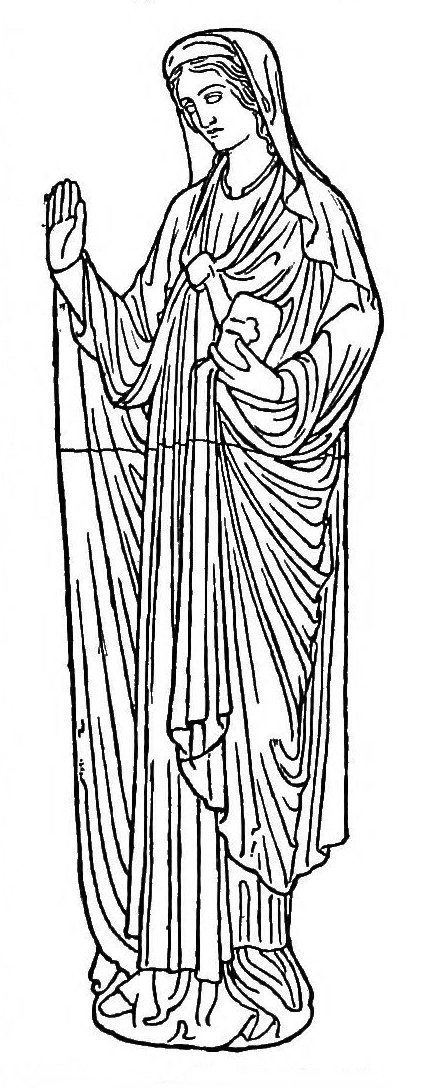
Fig. 50.—Gothic Architectural Figure.
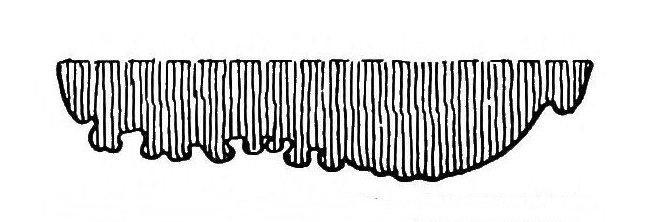
Fig. 51.—Section of Greek bas-relief.
It has already been stated in the earlier portion of this work that the Greeks ornamented their draperies with diapers of sprigs, spots, stars, etc., and rich borders of meanders, waves, and scrolls. Byzantine costume also was ornamented with characteristic patterns. In mediæval times the designs became more ornate, until they reached the culminating point of richness in the thirteenth, fourteenth, and fifteenth centuries.
The works of the artists of this period no doubt reflected the richness of the costume of the time, and in a good many instances were true transcripts of dresses and costumes actually worn. In a greater number of instances, however, the artist adapted some existing pattern to the purpose he had in view, and in other instances the artist designed his own pattern, as both the painters and sculptors of this period were ornamentists also. It is not to be supposed, for example, that the pattern of the dress of Flora in Botticelli's "Spring" was purchased in any Florentine emporium. Complete dresses, suitable to the expression of the artist's idea, were not always to be had even in that splendid time.
If an artist sets up an embroidered dress on the lay figure or living model, and paints it, the operation is a comparatively simple one. It becomes little more than a mere question of imitation, and the artist chiefly concerns himself with the various problems of light and colour. If, however, a pattern has to be added to a particular cast of drapery certain rules of procedure must be observed, and it is in view of this event that the following brief remarks on the patterning of drapery are made:—
The term "diaper" was originally given to a silken fabric, greatly estimated for many centuries, but it is now generally understood to refer to any all-over, recurring pattern.
Complication of the pattern by the foldsTo take the simplest possible diaper of spots or circles as a commencement, it will be seen by referring to the illustration (Fig. 52) that the foldings of the drapery at once complicate the pattern, and complicate it in proportion to the number and closeness of the folds, and gives it added variety. All patterns of textiles are, or should be, designed with a view of this breaking up of the folds; a pattern which may be comparatively uninteresting when seen in the flat may tell a very different story when broken up by folds. Fig. 53 is an ordinary pine-apple pattern of no special interest in itself, but it shows the degree of variety which may be arrived at by even a simple system of perpendicular folds.
Rules for the patterning of draperyPatterns for drapery may be as rich and ornate as the artist pleases, but the most effective are those which have a simple and well-defined system of leading lines. Simple casts of drapery are more suitable for patterning, as in a complicated system of folds, the pattern becomes too much confused, and the difficulties of applying the pattern properly to the drapery are enormously increased. In drawing the pattern on the folds it is obvious that the lines of the pattern must follow the contours of the folds. In a complicated system of folds absolute accuracy is not possible unless the pattern be drawn upon the actual drapery before the drapery is arranged; indeed, absolute accuracy is not necessary so long as the thing looks reasonable and right. It may, indeed, happen that the artist will find it necessary to deviate somewhat from absolute truth in order that his work may have a better decorative effect—in other words, to simplify in cases where the pattern becomes too involved. The eye of the practised designer is, after all, the best guide. Some decorative artists—especially in the case of stained glass, where the work is seen from a distance and the general effect is the main thing—will put a pattern on a dress without any, or with very little, reference to the folding—that is, a perfectly flat pattern all over, and just indicate a few lines of folds on the top. This practice, however, is not in any way to be defended. And, again especially in stained glass, if a figure happens to be weak in design a rich pattern will be put all over, in order to hide its structural defects. In this way a pattern often covers a multitude of sins.
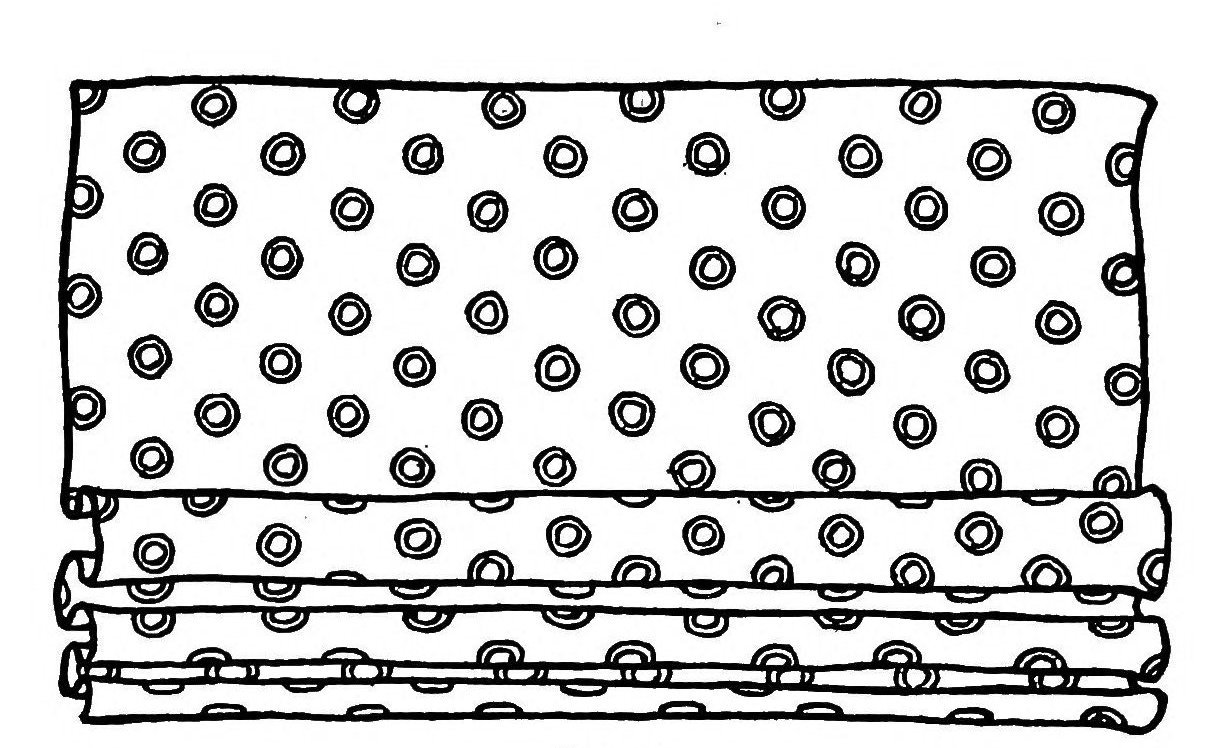
Fig. 52.
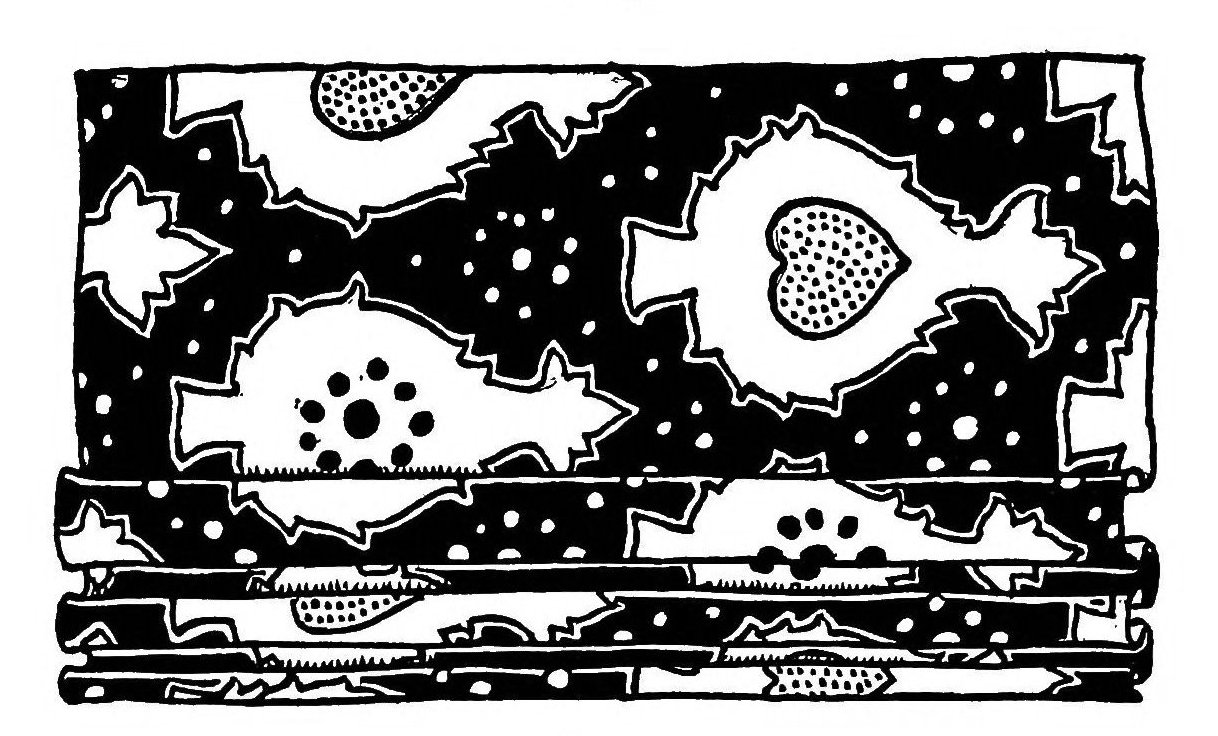
Fig. 53.
The Ornamentation of Drapery.
The study of Carlo Crivelli
The painter par excellence of patterns and diapers is the Venetian, Carlo Crivelli. Several examples are given from the works of this unique master, whose drapery was wrought with the same perfection of finish as the diapers and patterns which covered it. No master is so well worthy of the attention of the student, and no master is so little studied, yet the facilities for the study of this painter are, perhaps, greater in London than in any city of Europe. Carlo Crivelli's work is conceived entirely from the ornamental or decorative standpoint; each figure is an ornamental composition in itself. A favourite device of this artist for giving an added richness to his figures is to ornament those portions of the under side of the drapery which are visible—in other words, the turnovers—with a rich, close liney pattern, in contrast with the larger and more open pattern on the outer portions of the dress, or to richly ornament the turnovers and to leave the upper surface comparatively plain. The diaper given in Fig. 54 is from the dress of the Virgin in the National Gallery; the pattern is flat gold on a dark blue ground.

Fig. 54.—Diaper Pattern. Carlo Crivelli. National Gallery.
In the interesting picture of the "Virgin and Child," with the large swag of fruit, by Crivelli—an early work—the pattern of the drapery on the head and shoulders of the Virgin is strongly emphasised. It forms the chief decorative feature of the composition, and gives an added piquancy and freshness to the whole work.
In the picture of the "Adoration of the Magi," by Gentile da Fabriano, in the Uffizi at Florence, richness in patterning is, perhaps, carried to its utmost limit, and with great judgment. The strongest possible degree of contrast is obtained between the magnificence of the dresses of the three kings and the simplicity of the holy group at the manger. Indeed, the whole effect of this picture is most sumptuous, both in design and colour, and is one of the most beautiful pictures in Florence.
Mantegna was very fond of a meandering all-over pattern, giving the effect of watered silk, as a contrast to more purely ornamental patterns of figures in the same composition. In this he has been imitated by our great contemporary Burne-Jones, who formed his style, perhaps, more on Mantegna and Botticelli than upon any other master.
 |
|
| Hanfstängl photo] | [Lateran Gallery |
| VIRGIN AND CHILD (By Carlo Crivelli) |
|
 |
|
| Alinari photo] | [Verona |
| VIRGIN AND CHILD (By Carlo Crivelli) |
|
The later Venetians—Titian, Tintoretto, Paul Veronese, Bassano—employed patterns to give an added richness to their already ornate compositions. These patterns are always introduced with great judgment and knowledge of picturesque effect. They are, however, wrought from the standpoint of the painter rather than of the designer. The qualities sought after are those of effects of colour, the disposition of the masses of light and shade, and the play of light upon rich stuffs. In such a picture as "The Family of Darius at the Feet of Alexander," by Veronese, in the National Gallery, the rather coarse patterns are put in with a broad hog-hair tool; powerfully indeed, but in an apparently hurried manner, as though the getting over of the very considerable space were the one thing needful, and with none of that refinement and love of the pattern itself which is distinguishable in the work of Carlo Crivelli or the earlier Florentine painters.
The list of painters who have made use of rich patternings in their draperies is a very long one, and includes most of the earlier painters—Orcagna, Fra Angelico, Bonfigli, Taddeo Gaddi, Pincturicchio, Ghirlandajo, and many others, to Carpaccio, Paul Veronese, and others among the Venetians.
In this connection the paintings on the Italian marriage coffers of the fourteenth and fifteenth centuries should be studied.
Flemish draperyFlemish draperies are characterised by great distinctness in the structure of the folds. The eyes and general form of which have the sharpness and squareness belonging to the harder and heavier materials. The draperies, particularly in tapestry, are often covered with the most sumptuous patternings, imparting great richness of decorative effect to the whole.
ColourClosely allied to the question of the ornamentation of drapery is that of colour. It is, however, impossible to deal effectively in a work like this with the great and important question of colour unless colour illustrations or diagrams are given. There are two separate and distinct matters relating to colour—viz. colour arrangement and colour quality. It is said of Titian that he possessed so fine an eye for colour that he was able to produce harmony by any arrangement, and this is no doubt true. The feeling for colour—that is, colour quality—is native to the individual, and cannot, properly speaking, be taught. Colour arrangement is, however, subject to well-defined rules, and laws of harmony and contrast. A very good lesson with regard to the massing and arrangement of colour in a composition of draped figures is to be learnt from the work of an artist who is not, properly speaking, a colourist—viz. the two frescoes, in the Victoria and Albert Museum, of the Arts of Peace and War (especially the latter) by Lord Leighton. The way in which one colour gradually leads up to another, from, say, a mass of purple and red, through the various tones of orange, blue, and grey, is quite admirable. The small colour sketches should be studied, as the frescoes themselves have suffered much from the mistake of the artist in employing a rough ground, which catches the dust in its interstices.
For splendour of colour in its highest development the work of the later Venetians must be studied.
In any composition involving a number of draped figures the difficulties which are experienced in the arrangement of the drapery of a single figure are, of course, multiplied almost indefinitely. At the same time the service which drapery renders in a large composition of figures is considerable.
A comparison of the original pen drawing, in the Oxford collection, of Raphael's "Massacre of the Innocents," with the completed engraving of the same subject by Marc Antonio, demonstrates at once the part which drapery plays in a composition of figures, and shows the way in which the figures are amplified and the composition united.
 |
|
| Hanfstängl photo] | [Munich |
| THE ENTOMBMENT (By Botticelli) |
|
Amongst the most famous compositions in which drapery plays an important part are Raphael's great frescoes in the Vatican—"The Parnassus," "The Heliodorus," and the "School of Athens." We select, however, for purposes of analysis, as being less involved than these, and more easily grasped by the student, the picture of the "Entombment" by Botticelli, which is one of the latest works of this master, and on the whole one of the most perfect compositions which he produced.
First it should be noticed how admirably and forcibly the subject is illustrated; the general disposition of the figures exhibits the greatest judgment; the figure of the dead Christ, the pivot upon which the whole composition turns, occupying the centre of the picture. The arrangement of the three Marys is no less admirable: the virgin mother in the centre supporting her Divine Son, and being in turn supported by St. John, "the beloved"; the two other Marys—the mother of James and the Magdalen—at the head and feet of Jesus respectively. The composition is completed by a fourth female figure, probably Joanna, and three saints—SS. Peter, Paul, and Jerome.
The drapery is obviously studied from nature in almost every detail, and it is interesting to observe the manner in which it emphasises the general idea of the composition. The folds are continuous, clearly defined, and not too much broken up, and there is a squareness and severity about them which befits the gravity of the subject.
The design as a whole fulfils the first canon of good figure composition, nothing being introduced which does not directly bear upon the leading idea.
The study for an allegorical figure of Abundance by Botticelli, in the Malcolm collection, although presenting certain exaggerations in the matter of proportion, reflects the peculiar grace of Botticelli's style. A cornucopia has been placed in the right hand of the figure, and afterwards erased, together with other figures of Amorini to the right. The drapery is of that light gauzy character which is seen in the dancing figures of the Graces in this master's famous composition of "Spring," and the type of woman is similar to that of the figure of Flora in the same work. In the treatment of the lower portions of the drapery it will be noticed that Botticelli has observed the same fact pointed out in connection with the Japanese master Utamaro (page 70)—that the motion of the figure changes the perpendiculars of falling folds into folds of a more or less horizontal character, imparting at once a sense of movement to the figure.
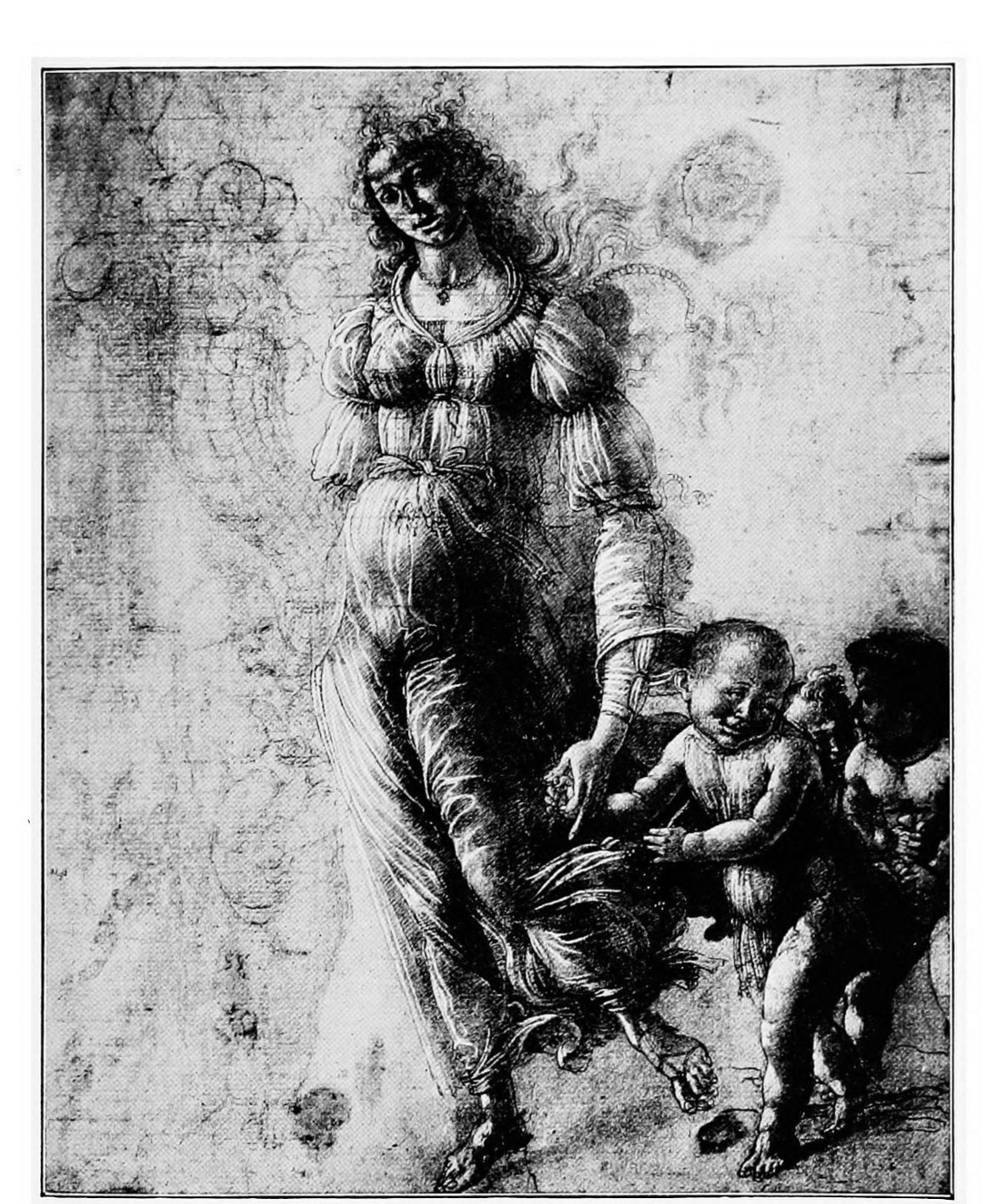 |
| [British Museum |
| ABUNDANCE (By Botticelli) |
Attention may also be drawn to the way in which the drapery is confined at different points—on the arms, underneath the breasts, and at the waist and shoulders; likewise to the little embellishments in the way of ornamentation, the transverse border across the breasts—a favourite motif with Botticelli—and the curious little piece of ornament around the umbilicus, which is perfectly clear in the original drawing, although somewhat obscure in the reproduction.
Mr Comyns Carr has suggested, with some degree of probability, that as Botticelli was attracted, from the evidence of two of his important works, to the subject of "The Seasons," this drawing may have been intended as a tentative embodiment of the idea of "Autumn" upon a similar scale, to be perhaps followed by the subject of "Winter."
The drawing was exhibited in the remarkable collection of studies by the great masters brought together by the Grosvenor Gallery authorities some fifteen years ago.
The picture of "St. George," by Tintoretto, belongs to what Sir Joshua Reynolds calls the "ornamental" school of painters—men who looked at nature from the standpoint of colour alone—and it is, perhaps, somewhat unfair to consider such work from any other standpoint than that of colour. It may, however, be instructive to the student to consider, in such a picture as this of "St. George," how Sacrifices made to the quality of "Colour" by the later Venetians much is sacrificed to this single quality of colour. First, as to what may be called its "storiation," or the expression of the idea. One is puzzled at the introduction of the naked man, who appears to be dead, and how he comes to be naked in company with this richly-dressed Venetian. The action of the piece is composed of five different elements, in the following order of importance:—the lady, the corpse, the dragon, the saint on his horse, and the glory, or supernatural appearance in the heavens—and the attention of the beholder is divided by these several parts, with a consequent lack of concentration or principal point of interest. The corpse, as a matter of fact, is a superfluity, and tends to confusion of idea. If it were buried—it is usually desirable that corpses should be decently interred—and the "glory" in the heavens dispensed with, leaving the saint and the dragon to settle accounts with each other, and the lady to run away, or stay, as she pleases, our attention would then be fixed upon the intended victim of the dragon's wrath—the lady (if she stayed), and the fate of her would-be destroyer—and the picture infinitely improved as a figure composition.
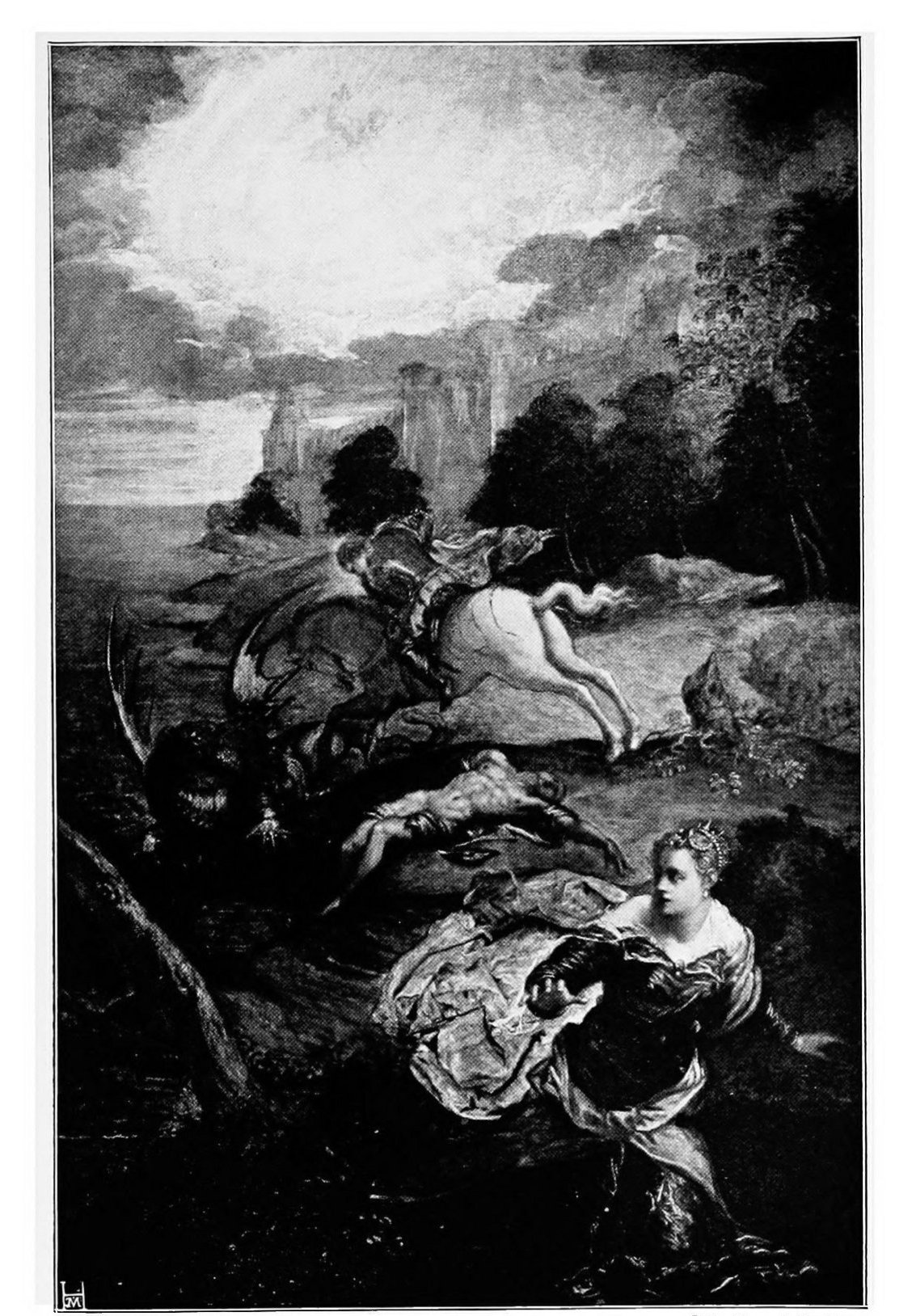 |
|
| Hanfstängl photo] | [National Gallery |
| ST. GEORGE AND THE DRAGON (By Tintoretto) |
|
The truth is, Tintoretto introduced this nude man solely with the idea of displaying his knowledge, or assumed knowledge, of the figure, and without any regard to probability or even propriety. Tintoretto wished people to believe that he knew as much of the figure as Michael Angelo; whereas his knowledge of the figure was really of the most superficial character, as even the most cursory study of his drawings will show.
The lighting of the picture, too, is as singular as the figure arrangement. One would imagine that with such a bright appearance in the sky on such a dark day the whole picture would be lighted from this "appearance," so as to preserve a unity in the general effect. Not so, however. The principal figure is lighted—and strongly lighted too—from the dark hole at the right-hand corner of the picture! More than this, the form of the lady, although of a sufficiently substantial character, and so strongly lighted, casts no shadow on the floating drapery immediately behind!
It must be confessed that the terror expressed in the lady's face and attitude is of a particularly mild character, and tends to produce the uncomfortable impression that the whole thing is a make-believe.
Blake's comments on Venetian workIt is small wonder, then, that work of this character should excite the scorn of serious-minded men like Blake, whose couplet to the "Venetian painter" runs:
"He makes the lame to walk, we all agree;
But then he strives to blind all who can see!"
And again, on colourists:
"Call that the public voice which is their error?
Like as a monkey, peeping in a mirror,
Admireth all his colours brown and warm,
And never once perceives his ugly form."
It is somewhat curious that Blake's own friends, more especially in the case of Samuel Palmer, from whom better things might be expected, should endeavour to excuse his attitude towards the later Venetians by saying that he picked up his notions of the Venetians from picture-dealers' samples, and coarse engravings. It was not in the least so. Blake knew perfectly well what he was about, and was no madman—quite other, indeed, than a madman.
There exists considerable difference of opinion amongst artists as to the utility of the lay figure, some holding that the use of it tends to a certain stiffness and formality in the arrangement of the drapery, wanting that ease and natural flow which any cast of drapery upon the living model gives. Upon being asked if he made use of the lay figure Sir L. Alma-Tadema replied emphatically: "Never; always the living model." On the other hand, Sir Edward Poynter expressed the opinion that the lay figure is of service for drapery which remains stationary, or which is not influenced by the action of the figure. For purely costume studies there is no doubt of its utility, and also for studies of parts of drapery in which it is necessary to give more completeness of detail than is possible in the comparatively short time during which a model is able to keep the same pose. Sir Edward Poynter further stated that he made use of separate studies for purely decorative work, but for the more pictorial work he painted direct from the living model, except in cases of figures in violent action, when separate studies are absolutely necessary, and he remarked that drapery behaves pretty much the same on the model from day to day under the same conditions, and he is able to finish a certain portion in one day and to count upon the folds being similar at the next sitting.
In connection with the use of the lay figure there is one consideration which may possibly commend itself to those less fortunate artists in a pecuniary sense: that a lay figure costs nothing to keep, that it is always to hand, and that there are none of those disappointments which are experienced in connection with the engaging of models, especially those whose services are much in request. There is, consequently, a tendency to make use of the lay figure on occasions when a living model would much better serve the purpose.
It is impossible to lay down any precise rule or law, either with respect to the use of the lay figure, or as to the utility of making preparatory studies. Men's practice differs very much; what suits one temperament will not suit another. As a rule (Holbein was an exception to this rule) the realist paints direct from nature, the idealist from a series of carefully prepared studies. Leighton's practice was Leighton's practice for studies to make a preliminary sketch of the general composition. Then he would make a study of the nude figure, and afterwards a study of drapery upon the living model, working, as a rule, as long as the model was able to keep the pose, often making studies of such details or portions of the drapery as suggested happily.
Mr Holman Hunt's methodIn answer to a question as to his practice with regard to drapery in motion Mr Holman Hunt writes: "I have made few preparatory drawings for the figures in my pictures, either for heads, hands, or draperies, because in my practice I find that to settle these on separate sheets is to lose the vital relation of one part of the picture to the other, both as to composition of line and expression.
"For the same reason I may say in answer to your further question about moving drapery, that I always compose it on the canvas itself, where I am able to keep account of the surroundings far and near.
"If in doing this I want some characteristic forms I take the opportunity of moving drapery before me, or watching it when blown by the wind."
In arranging a cast of drapery either upon the lay figure or upon the living model care must be taken not to tease and trouble the folds by trying to rearrange what is an unsatisfactory throw, as the more the drapery is pulled about, the poorer it is sure to become. "It is better to take the chance of another casual throw than to alter the position in which it was at first accidentally cast."[1]
Lay figures are either of wood, of papier-mache, or stuffed; the latter are perhaps the best, as the joints of the two former are a trouble. The spaces which the working of the joints necessitate, interfere with the folds and effect of the drapery, especially if the material be thin.
Ford Madox-BrownIn considering the draperies of that extremely individual and not sufficiently appreciated artist, Ford Madox-Brown, care must be taken to differentiate between costume and drapery. While Madox-Brown's costume is wrought with the utmost fidelity to nature, and with a quaint sense of style which is quite unique, the character of the individual folds of his drapery is less satisfactory, possessing a certain flaccidity, which was no doubt to a great extent determined by his method, which was in some sense, as in the case of Donatello and Dürer, a revolt against convention, possessing nothing of the ordered sequence of
the classics or the Italian idealists, but was always in the highest degree expressive of the idea which it was intended to convey.
The present writer has, fortunately, had the best possible opportunities of observing and becoming acquainted with this masters practice. Madox-Brown was a realist pure and simple; his system was to do nothing in his pictures, not even the most unimportant detail, without direct reference to nature as far as possible, and he would go to any amount of trouble in the choice of his models, the selection and preparation of his costumes and dresses, the arrangement of the lighting, etc., to obtain the desired result. The lay figure, as well as the living model was made use of for costumes and draperies; and his practice was to paint direct from the model or object rather than to make a series of separate studies, but this was always done with an eye for the decorative and ornamental qualities of his subject.
Diffusing the light on the modelMadox-Brown was accustomed to fix up a tentlike arrangement in his studio to diffuse the light upon his model and enable him to get the effect of open air on those occasions when it was impossible or inconvenient to have a model in the open. It was composed of four sheets for the sides and one for the top, with a small opening in front to enable him to see through. He said: "Of course, it is much lower in tone, but one can allow for that." It may very possibly be inferred from this that Madox-Brown was not a very enthusiastic "plein-airist." As a matter of fact, to make use of an Irishism, Madox-Brown was a plein-airist before there were any. In other words, he was one of the very first to exchange the conventional studio lighting of pictures for the outdoor effect. Mrs Rossetti relates that as early as 1845 Madox-Brown discussed this dream of his—as it then was—with a young French artist friend, who considered the innovation impossible. No one has painted more in the open air than Madox-Brown. In truth, this "plein-air" is one of the modern cant catchwords. There are many such, and all have become equally nauseous. In many large studios a portion is made entirely of glass, like a large conservatory, in which the open-air effect is obtained exactly. This device of Madox-Brown's is, however, very useful in the absence of such convenience.
Slow productiveness of modern paintersHolman Hunt's practice, previously quoted, of never making preliminary studies, but arranging the parts on the actual canvas, seems incompatible with ordered arrangement or completeness of design, but it should be remembered that Holman Hunt's practice is slow as compared to that of the great Italians. His work is, indeed, carried further in elaboration of detail and inventive idea, but the "output" of any of the great Italians is relatively much greater. In the opinion of the present writer the picture of the "Triumph of the Innocents" is one of the world's masterpieces. The work, however, extended over a period of something like seven years. Michael Angelo covered the whole of the vaulting of the Sistine Chapel within the period of four years. The presumption is, therefore, that although the making of the various preparatory studies occupies a considerable time—in some cases longer than the actual painting of the picture—yet it is, upon the whole, the shorter process, assuming that the results are similar.
This matter of slow productiveness is a modern characteristic. (Great artists only, are here referred to; the "output" of the ordinary picture-maker has assumed proportions which are positively alarming.) We are over-fastidious; we strive for absolute perfection; we accomplish too little because we attempt too much. If we were content with less we should be more successful. We seem to be afraid of criticism, and endeavour to produce work which shall not by any possibility give a handle to cavillers; we refine and over-refine. The Wellington Monument in St Paul's The Wellington Monument in St. Paul's is a case in point. The present writer is assured by one of Stevens' pupils that every scrap of ornament on this monument was designed and redesigned at least a hundred times. The work extended over a period of something like eighteen years, and was left unfinished at the end of it. Donatello or Verrocchio would have done a dozen monuments in the same time, and if Stevens had done a dozen in the time he would have done them better. Even Mantegna, who was a slow and painstaking worker, completed the series of paintings in the Eremitani Chapel at Padua within a period of six years, and that, too, at the outset of his career, when he was, in fact, a boy, the work being begun when he was but eighteen.
|
Sir Joshua Reynolds. Twelfth Discourse. |
With respect to material and method of making drapery studies, no doubt black and white chalk on some kind of tinted paper is the readiest means, and the best for those who can express themselves in this way. It does not, however, suit everybody. The drawback to this method is the difficulty of fixing white chalk, and the drawings get rubbed. There is a fixative sold for pastel and chalk, but it takes the bloom off the drawing. Sir Edward Poynter has literally hundreds of studies lying loose in his drawers. He says: "I frame the best of them; it is impossible to fix white chalk satisfactorily."
Silver pointThe old masters employed silver point, pen, pen and wash, pen heightened with white, and crayon, black and red. Against silver point there is nothing to be said; within its limits it is a beautiful medium.
Pen and inkThe pen is a most difficult instrument to use, and it is a question whether it is entirely suitable for anything but pure outline. Few have the power and facility of a Dürer. Michael Angelo used the pen in an extremely powerful manner. Many of his studies, drapery and figure, were highly wrought, with the lines crossed at right angles, as was his wont; of course, the pen was either reed or quill.
Red chalkThere is a certain quality about red chalk which is attractive; it is not, however, suitable for studies of a very searching character. It was much employed by artists of the later and colour schools—Correggio and others. Alfred Stevens invariably employed red chalk for his studies, both drapery and figure.
Lord Leighton's studies were usually done on brown paper, which is an excellent material, as, when not too dark, and of a good quality, the colour is extremely pleasant. The study for "Persephone" given in these pages is in Lord Leighton's happiest vein. It is on a buff-brown paper, with the white chalk worked a good deal into the black, giving a light silvery effect to the drawing, and suggesting very well the material of Indian muslin, which is the material employed for this kind of drapery. Much working of the white chalk amongst the black is a practice which is not generally to be recommended, as, if not done skilfully, it is apt to give the drawing a smoky character. It is, however, impossible to avoid something of this in the making of rapid studies.
Leonardo da Vinci and some of his contemporaries, together with a number of artists who preceded him, made use of a paper of varying tints of olive green. A number of drawings in the Royal and other collections are executed on this, often with a dark brown crayon. The effect is extremely happy.
Sir E. Burne-JonesSir Edward Burne-Jones tried every method, and almost every material. A large number of his studies was done with a very hard pencil upon hot-pressed Whatman, giving something of the delicacy of a silver point. This method seemed to suit his particular temperament and the peculiar beauties of his style. It was a common practice for him in the case of drapery studies to employ two pencils, a very soft and a very hard one, upon a rougher paper, the hard pencil for the lighter tones. By this means he obtained two different qualities of texture, with the happiest result. During the latter years of his life Burne-Jones employed paper of various fanciful tints (possibly, let us suggest, with the idea of making his drawings more attractive to buyers), and even heightened the lights with gold, after the manner of the earlier painters. A comprehensive study of Burne-Jones' drawings is an education in itself, and serves to reveal by what slow and patient process a great picture is built up: from the first impressions, which are merely tentative, to the most exhaustive study of apparently unimportant detail, which often reveals more of the artist's mind than the completed picture itself.
 |
|
| Alinari photo] | [Campanile, Florence |
| IL ZUCCONE (By Donatello) |
|
Of the illustrations in this work not hitherto mentioned, the figure of "Il Zuccone" by Donatello is by far the most remarkable. It was one of the figures designed and executed for Giotto's Campanile at Florence, and really represents King David—Zuccone being a nickname referring to the bald pate of the figure.
Vasari says: "The latter (Zuccone) is considered the most extraordinary and most beautiful work ever produced by Donatello, who, when he intended to affirm a thing which should preclude all doubt, would say: 'By the faith that I place in my Zuccone.'"
There are some men who, by the loftiness of their ideas and aims and their power of giving expression to them, place themselves above criticism. Donatello is one of these. We cannot venture to criticise the work of so great an artist; our business must be to accept. "Let none presume to measure the irregularities of Michael Angelo and Socrates by village scales."[1] We can only say, however, that this figure of Zuccone runs counter to, and is in direct defiance of, every law of drapery as enunciated by almost every master from the very earliest times. It has often seemed to us that the work of the great modern sculptor Rodin is directly inspired by, and to some extent founded on, Donatello, and especially this figure of Zuccone seems to suggest the work of Rodin.
The work of MantegnaIn force, intensity of passion, and a certain austerity, and even harshness of style, Mantegna claims some degree of kinship with the great Florentine artist just referred to. Mantegna's style was, however, founded upon a study of the antique, the principles and spirit of which was instilled into him early—in the school of Squarcione, who was a collector, and whose pupil he was. It remained an influence with him throughout his life, to the time when he parted with his well-loved "Faustina," which Isabella D'Este had long coveted and at the last obtained.
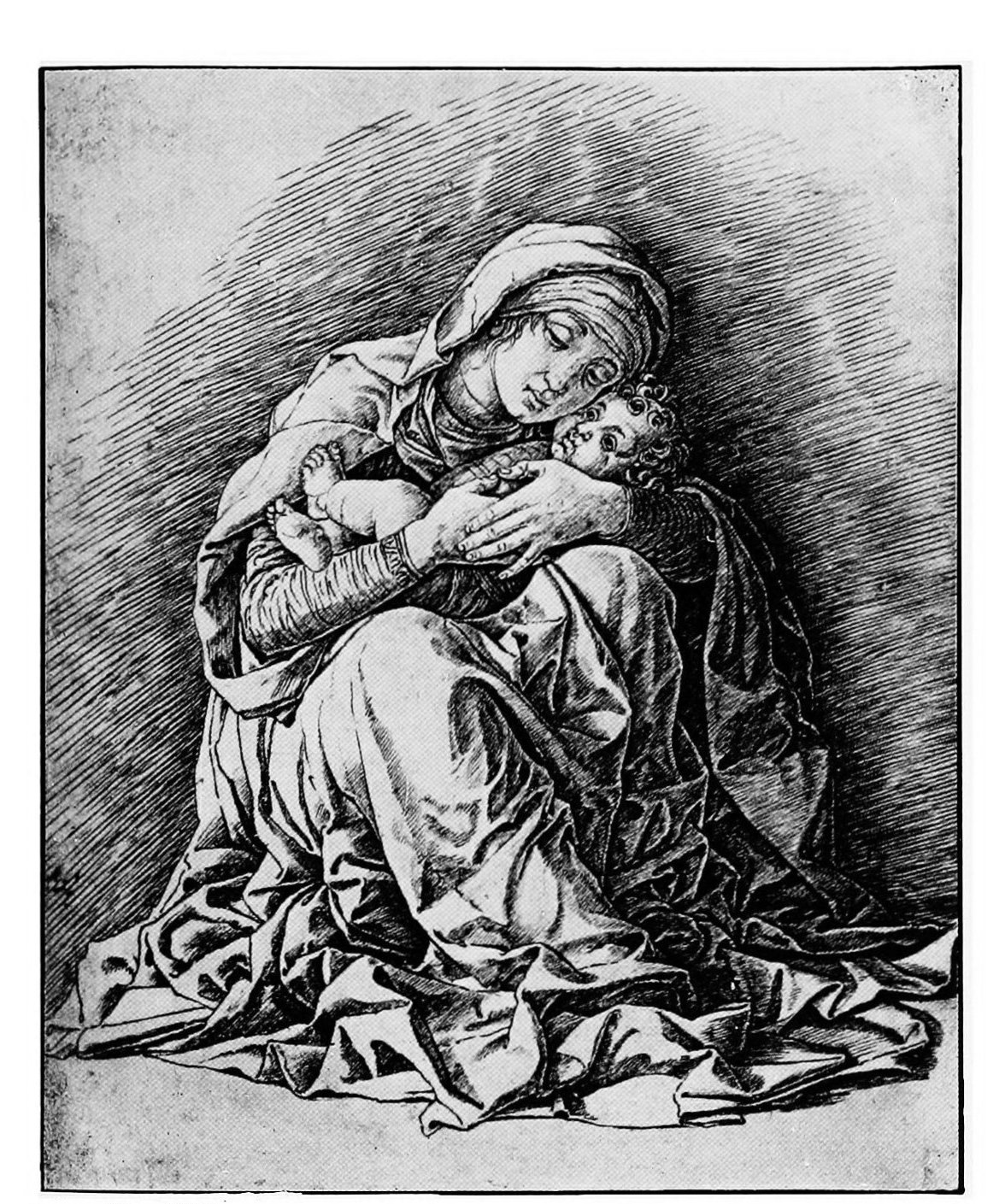 |
| From an Engraving] |
| MADONNA AND CHILD (By Mantenga) |
 |
| [Windsor Castle |
| STUDY FOR A KNEELING FIGURE (By Leonardo da Vinci) |
Mantegna's drapery always betrays this classic influence, tempered, however, by an innate individuality which no outside influence could entirely overcome. Mantegna was not
content to allow the impressions which he received from the antique to entirely dominate him. There is in his work a spirit of unflinching realism which is native to him and foreign to the antique. The example here given of the seated Virgin and Child is a noble composition, forcible and convincing to the last degree, but owing to the limitations of the method employed (engraving) can scarcely be said to convey so complete an impression; or, rather, let us say, it conveys a different impression from that of his painting, which is highly modelled and complete in its expression of the subtle variations of light and shade.
We have in England the best possible opportunities for the study of this great master, as this country is fortunate in the possession of some of his finest works. The picture of the "Triumph of Scipio" is only one of several fine examples of Mantegna in the National Gallery. The noble series of paintings at Hampton Court, however, loses something of its educational value by being some distance from a great educational centre, and also, we may add, from being hung in a gallery which is ill adapted to purposes of study.
Leonardo da VinciThe study for a kneeling figure by Leonardo da Vinci, from the Royal collection at Windsor, is one of the most perfect examples of this master in existence. The folds are easy, continuous, and replete with the most delicate grace.
Of Leonardo's fascinating personality, and the great and lasting influence which he exercised, there is nothing new to be said. It suffices to say that he remains the greatest master of pure draughtsmanship who has ever lived—of draughtsmanship, that is, as distinct from actual knowledge of his subject. There is a beauty of draughtsmanship per se, as we speak of style and manner in painting, quite apart from the thing depicted. Leonardo possessed this to a greater degree than any of his contemporaries, and certainly than any of his successors.
Luca della RobbiaThe panel of Singing Angels from the marble cantoria by Luca della Robbia, which was once in the Duomo at Florence and is now in the Bargello, is one of the most interesting portions of this work so far as drapery is concerned. A complete cast of this work as it appeared in its original position at Florence is to be seen in the Victoria and Albert Museum.
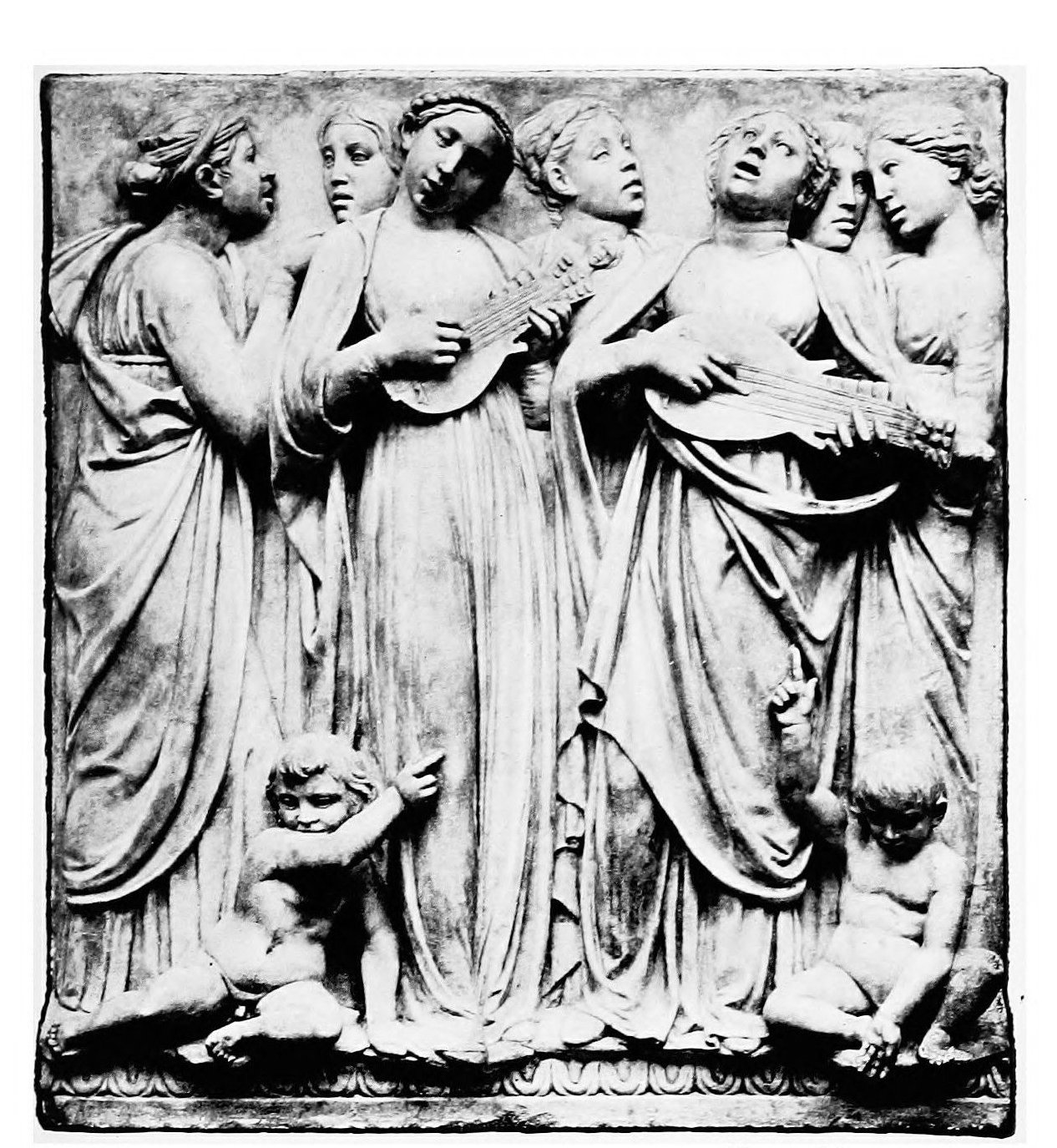 |
|
| Brogi photo] | [Duomo Museum, Florence |
| PORTION OF THE SINGING GALLERY (By Luca della Robbia) |
|

KNEELING ANGELS
(By Benozzo Gozzoli)
The group of Kneeling Angels by Benozzo Gozzoli is a charming example of a most interesting master. The drapery of the lower portion of the figures is treated in an admirable manner, and the figure asserts itself, for the subject, sufficiently. The drapery of kneeling figures is exceedingly difficult to treat, as when the figure is made to assert itself, the folds of the drapery are generally scanty. Benozzo has overcome this difficulty by making the folds hang loosely, and the effect is extremely decorative. Benozzo's chief works are in the Riccardi Chapel at Florence, from which this illustration is taken, and the Campo Santo at Pisa.
Gaudenzio FerrariThe charming group of Angels from the cupola of Santa Maria dei Miracoli at Saronno, by Gaudenzio Ferrari is an example of an artist far too little known in this country, and, possibly also, elsewhere. The present writer has long been an ardent worshipper at the shrine of this delightful artist. It is indeed surprising that the work of an artist of the calibre of Gaudenzio should so long remain unheeded. Vasari dismisses him in a couple of paragraphs, and this is somewhat surprising considering that Vasari's sympathies lay with the men of the later schools. It is curious to notice how reputations change in art. From the pages of Vasari one would gather that Botticelli was a fourth or fifth rate artist.
The value of Vasari's book lies, and always will lie, in the fact that he knew personally most of the men whom he wrote about. His book is an echo of the time, and imparts the flavour of the times in which he lived. Vasari himself was a decadent of the decadents. His own work is comparatively worthless.
Gaudenzio Ferrari is, unfortunately, not an isolated instance of sterling qualities being neglected. The list is a painfully long one of men who have lived and worked, in many instances their lives through, until some critic, with a little more boldness, and perhaps a little more penetration than the rest, comes forward and draws attention to qualities which ought never to have remained obscure. The recent appearance of a little book on the work of Gaudenzio, by Miss Ethel Halsey, will doubtless do something to remove this anomaly so far as Gaudenzio is concerned, and he may be expected to take his natural place in the long list of illustrious names which made the fifteenth and sixteenth centuries unique in the history of art.
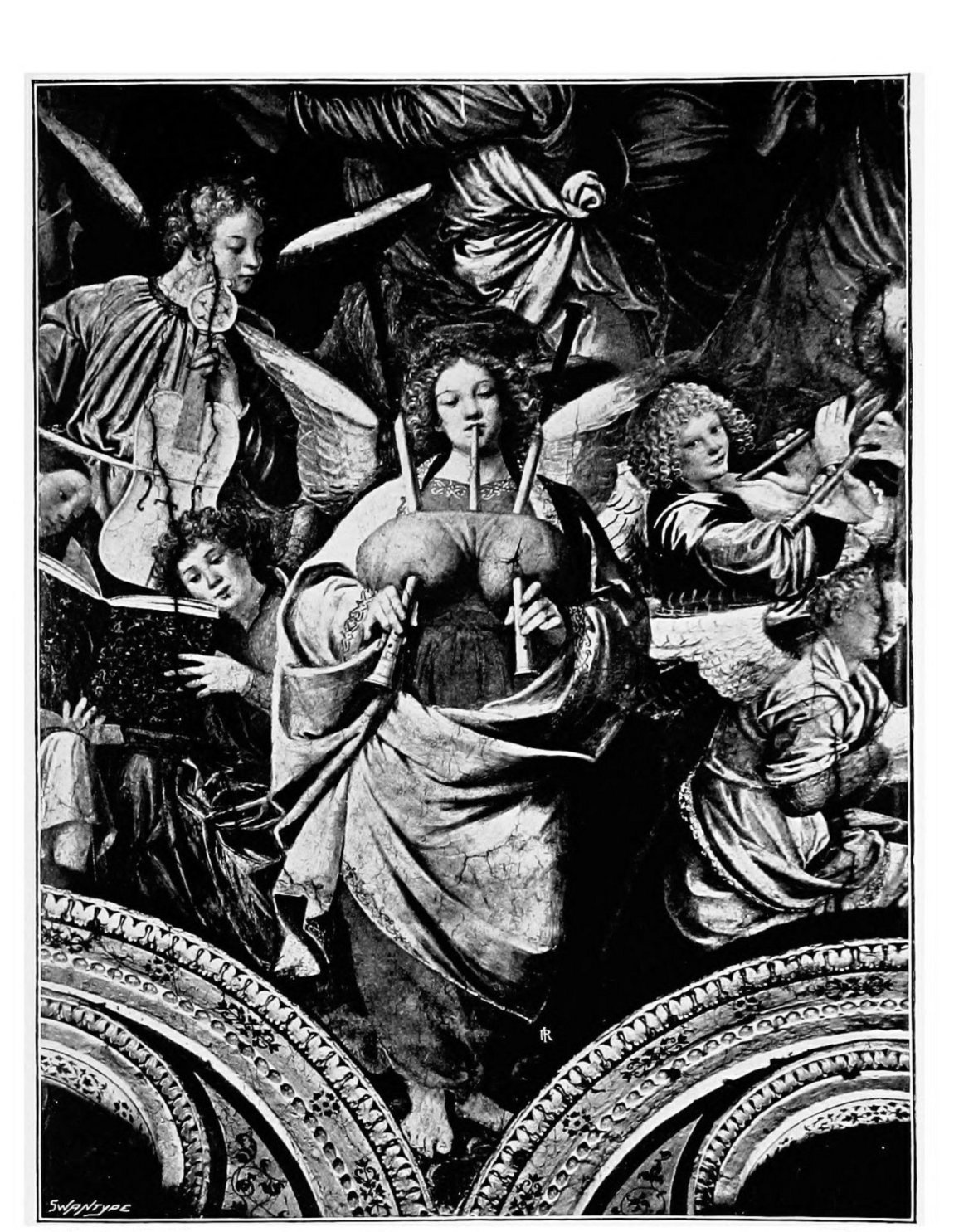 |
|
| Anderson photo] | [Saronno |
| DETAILS OF FRESCOES OF ANGELS IN THE COPULA (By Gaudenzio Ferrari) |
|
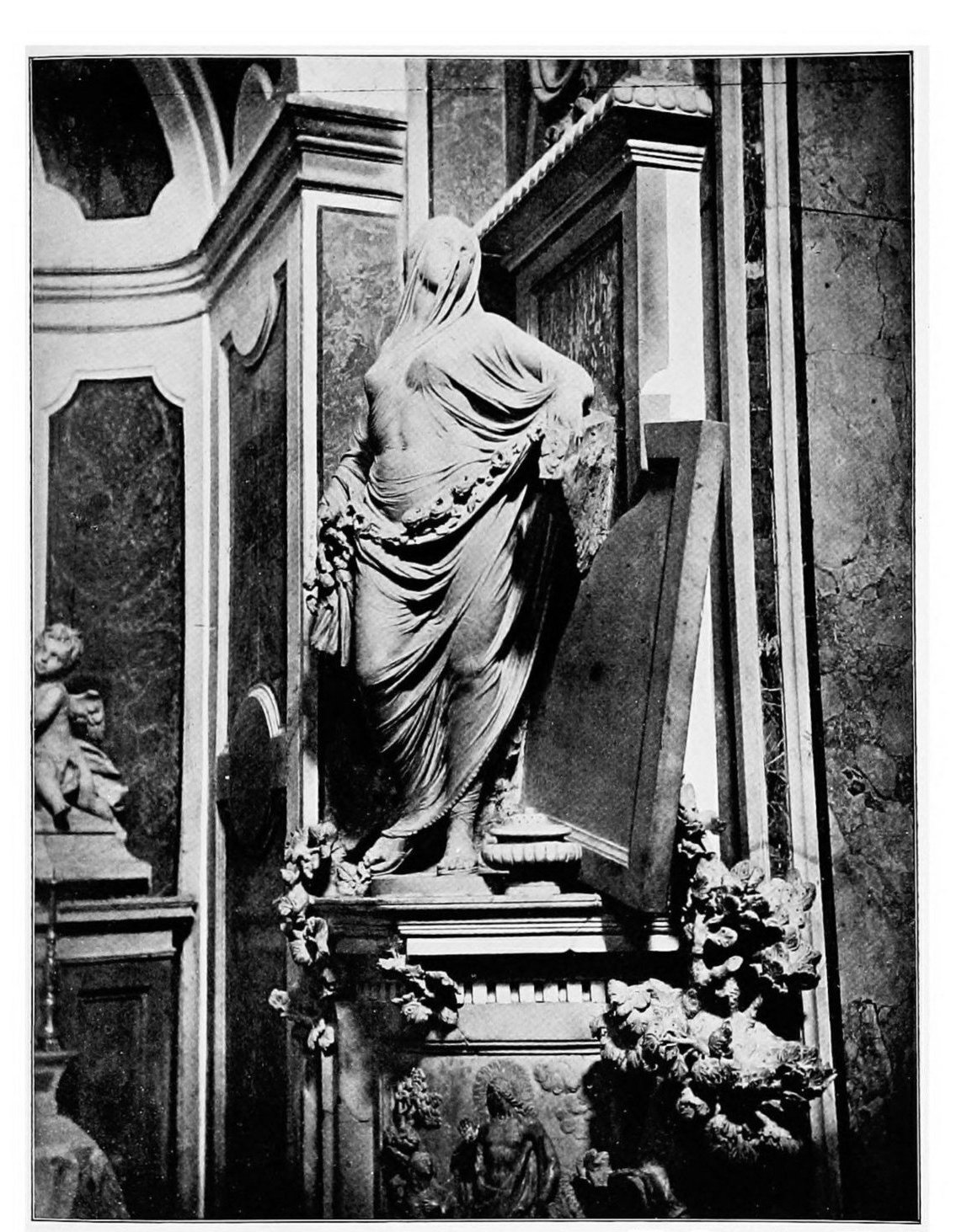 |
| [Church of S. Severo, Naples |
| MODESTY |
The remarkable veiled figure of Modesty, from the Church of San Severo at Naples, is given at the suggestion of Sir Edward Poynter, who remarked with some humour: "It is intended as a representation of modesty; a more immodest figure could scarcely be imagined!" Its power, however, is undeniable. The representation of the figure, and especially the features, beneath a more or less transparent veil is a favourite motif with Italian, and more particularly modern Italian, sculptors. A figure of a "Veiled Model" by Tantardini was shown in London some twenty-five years ago. It was a figure possessing some grace, and showing considerable skill in the manipulation of the light, gauzy folds, but with nothing of the force and power of the figure in this illustration.
The little statuettes of Mourning Monks from the Church of the Chartreuse at Dijon are quite the most admirable examples of the treatment of drapery of a graver and simpler kind. There are in all about a dozen or fourteen, and casts are to be seen in the Victoria and Albert Museum at South Kensington. The four given in the illustration are the best. Cantoni has cast and "published" two of them, and these two are gradually finding their way into the various schools. It is to be hoped that he will see his way to do more.
The work of Albert Moore is well known from the many reproductions of it which have been made during the last thirty years. It was founded, as was the work of Mantegna, upon a careful study of the antique, but here the resemblance ceases. No two men could possibly be more unlike, and no further comparison could by any possibility be entertained. Albert Moore approached the antique from a totally different standpoint to that of the great Lombard painter. He studied the less severe and more naturalistic draperies such as we are familiar with in the group of the "Three Fates" in the Elgin Collection. Albert Moore's work possesses a grace and charm peculiarly its own. The study given in these pages is a charming example of this master's slighter studies, and, while it possesses in a high degree the flavour of antique drapery, it could not have been produced at any other epoch than the present.
Anything like a complete consideration of the various works in which drapery has been treated successfully, or even of the men who produced them, is manifestly impossible here, and the difficulty has been to make a suitable selection from an immense mass of material. It should also be pointed out that the illustrations from the great masters given in this work are given not only as admirable examples of the treatment of drapery but also as illustrating some particular fact or principle connected with the subject.

STATUETTES OF MOURNING MONKS
(From the tombs of Philippe le
Hardi (d. 1464) and Jean Sans Peur (d. 1419), Dukes of Burgundy. Formerly in the
Chartreuse at Dijon now in Dijon Museum.)

STUDY
(By Albert Moore)
To conclude what must necessarily be a very incomplete survey, and as a last word, if one were asked to particularise the artists whose drapery is most worthy of study, one would say, for simplicity and purity of style, Fra Angelico; for beauty of draughtsmanship and easy grace in the continuity of the folds, Leonardo; for strength and grip of the construction of the individual folds, and richness of decorative effect, Dürer.
|
Emerson. "Representative Men." |

[The end of The Treatment of Drapery in Art by George Woolliscroft Rhead]